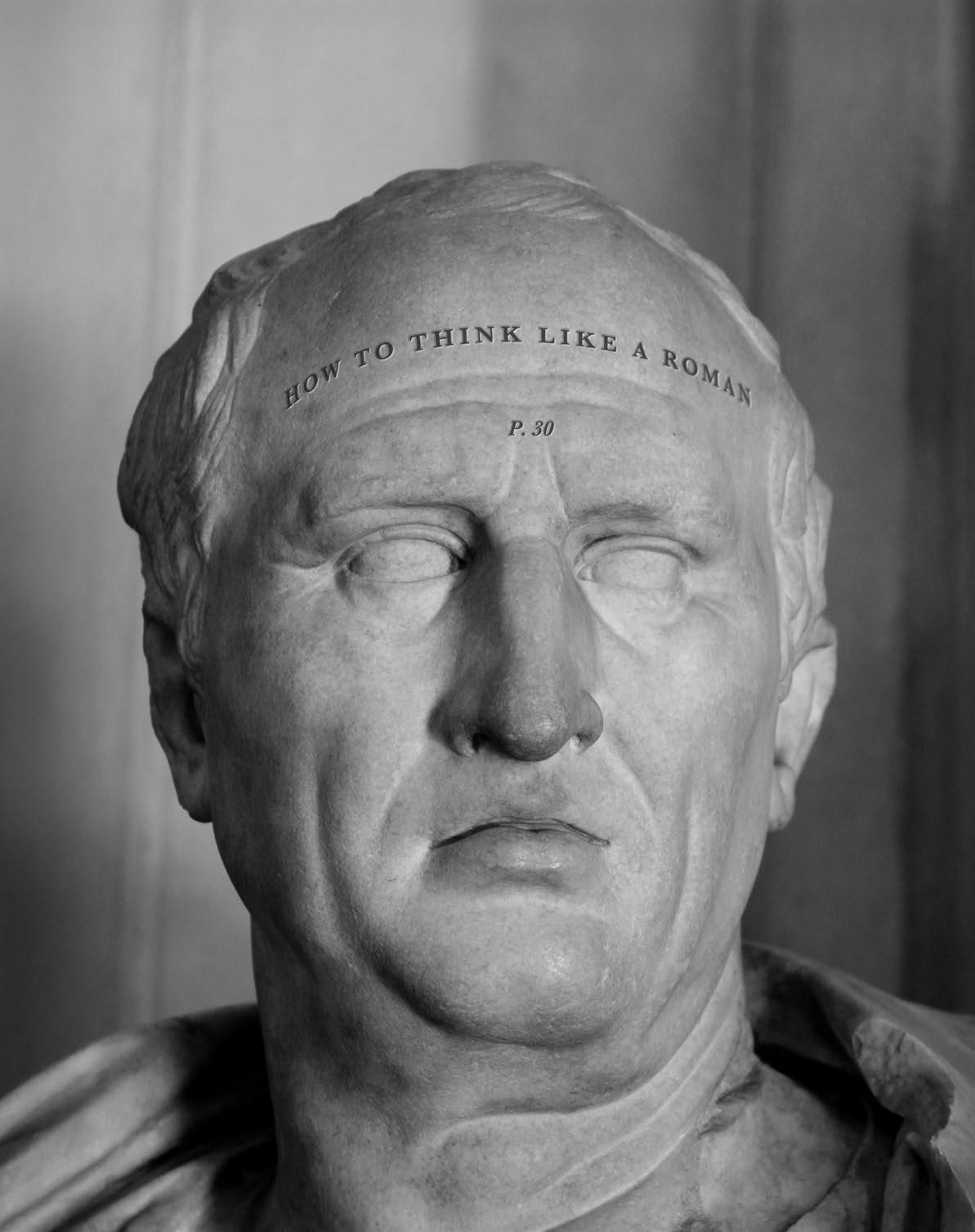

2025 Liberal Arts Commencement
Thursday, May 8, 2025, 6pm Moody Center

Dean’s Message
This is the final issue of Life & Letters that we’ll publish during my tenure as Dean of the College of Liberal Arts. Like those that preceded it, the spring 2025 issue of the magazine showcases the profound range and depth of the work that our faculty, students, and alumni are doing every day to make our campus and the world a richer place. What you’ll find in these pages is exceptional on its own terms, but it’s not exceptional for the college. It’s what we do.
Scientists are often categorized as doing either “basic” or “applied” science, and that imperfect dichotomy can be stretched to fit our work across liberal arts as well. There is the “basic” humanities and social science research that you see, for instance, in anthropologist Becca Lewis’s work on drought adaptation in lemurs; literary critic Jennifer Wilks’s new book on how Bizet’s opera Carmen has been adapted to reflect the experience of people in the African diaspora; and classicist Andrew Riggsby’s use of cognitive science to understand how the ancient Romans thought. There is also the “applied” work, like historian of photography Steve Hoelscher’s curation of an Ansel Adams exhibition for the Harry Ransom Center and psychologist David Yeager’s new book on getting the best from our youths, 10 to 25: The Science of Motivating Young People
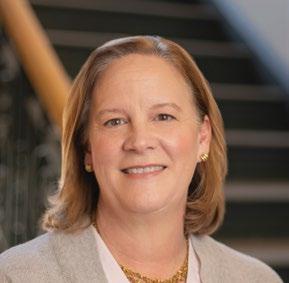
In our case, however, we have to add some additional categories. We make art, like Bret Anthony Johnston with his new novel We Burn Daylight. We plumb the mysteries of baseball and ancient wisdom literature, like Bruce Wells in the latest installment of our “Highbrow Advice for Life” column. We serve as stewards of the land and the communities who live upon it, as alumna Maria Farahani does in her native Nicaragua, where she and her husband own coffee farms. And we enrich democracy, as alumni Carl and Tamara Tricoli have done with their gift to incentivize civil discourse in the college.
This is all work that makes the world a richer and more humane place. It’s testament to why the liberal arts, and its habits and virtues of nuance and complexity, are worth fighting to preserve and expand.
It is difficult to say good-bye to colleagues and alumni engaged in and believing in this amazing work, but it is easier with the knowledge that so much of what I’ve loved about the college will continue and grow. Our alumni will provide unwavering support. Our exceptional staff in the college, departments, and centers will keep things moving forward. Our brilliant faculty will plumb the depths and crannies of human existence. And our bright young students will keep asking questions and looking for ways to change the world.
Ann Huff Stevens Dean, College of Liberal Arts David Bruton Jr. Regents Chair in Liberal Arts
Photo by Wyatt McSpadden
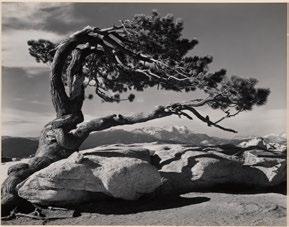
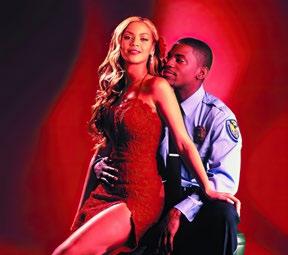
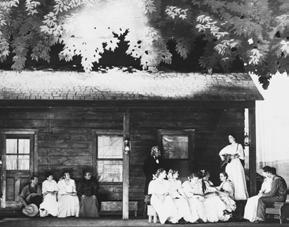
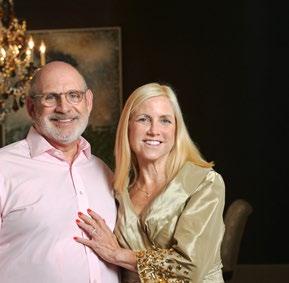
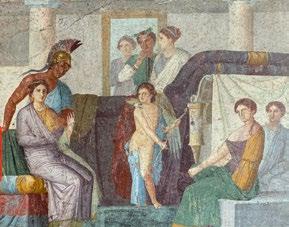
ON BASEBALL AND WISDOM
LITERATURE
By Bruce Wells
“I guess there’s more to life than baseball.” That was my older brother’s conclusion after the coach at his small college cut him from the team. My father thought it was rather funny that he was just now coming to this realization. My 10-year-old self was horrified. If my star-athlete brother hadn’t made his college baseball team, there was absolutely no hope for a middling player like me. And how on earth could there be more to life than baseball?
Figuring out what’s important in life is not for the faint of heart. I imagine that most of us can remember a time when we discovered, sometimes painfully, that there was more to life than, well, whatever it was that we thought there wasn’t more to life than. And while we can always learn this from experience, it’d sure be nice to have a little help along the way.
So, forget the self-help books of today. Let’s go back some 3,000 years to the world’s original selfhelp texts, to what’s usually called the “wisdom literature” of the ancient Middle East. You find it in ancient Mesopotamia, in ancient Egypt, and even in certain biblical books like Proverbs. A few scholars now argue that we should stop calling it “wisdom literature,”
mainly because my field has its own issues figuring out what’s important in life, but whatever you call it, this literature tries to offer advice on how to pay attention to the stuff in life that really matters.
One of its favorite things to say is that there is more to life than wealth. For example, the Egyptian “Instructions of Amenemope” say not to “cast your heart away in pursuit of riches . . . for they will make themselves wings like geese and fly away to the heavens.” In the Book of Proverbs you find, “Don’t struggle to gain wealth . . . You might see it, but then it’s gone. It sprouts wings and flies away like an eagle into the sky.” I admit I’ve never actually seen my money fly off above me, though; I find it just sneaks out the back door when I’m not looking.
The false allure of material success shows up in ancient stories as well. Take the biblical character
of Jacob, a major figure in the narratives of Genesis. He knows what he wants out of life and is determined to get it. If you know the stories, then you know that he gets the inheritance he wants, the fatherly blessing he wants, the woman he wants, the children he wants, the security he wants, and all the wealth he could possibly want. When he’s old, he moves to Egypt to be near his favorite son. At the ripe old age of 130, he has an audience with the Egyptian king, who asks Jacob about his life. “The years of my life have been few and hard,” he says. That’s not at all what you expect him to say. I wonder how someone like him would fill in the blank: “There’s more to life than .”
In the end we all have to decide for ourselves what there isn’t more to life than. But here’s what I can tell you. Stories like Jacob’s can help, and even some of those

pithy sayings from that formerlyknown-as-wisdom-literature literature — and meeting people that are like Jacob or maybe a little like Jacob or not like Jacob at all. Stories and people. And experience and history and poetry and art and a little philosophy and maybe a few more pithy sayings.
I think the stories are the best. They don’t offer us concrete
answers so much as an array of insights into what might be important. From the ancient Middle East to our own modern time we have loads of stories, fictional and factual, about all kinds of different people. A lot of them are sad because — not to put to fine a point on it — our ilk has never been great at figuring this out. But many of them have happy endings, where people zero
in on what really matters and live meaningful lives in accordance thereto. The more stories we read, the better our chances of getting it right.
Now if I could find a place not too far away that would let a bespectacled middle-aged man play a little baseball, I could finally put paid to the notion that my brother had any idea what he was talking about.
Gate of Life
by Kyle Okeke
Quiet, says the officer walking me to the office, after I flashed my knife in school— the footsteps scuffing, shuffling—rain-like.
All of it moving because I am moving.
After the flood, a quiet rose
like a shirt off a body of land.
Bruce Wells is an associate professor of Middle Eastern studies at UT Austin. He specializes in the study of the Hebrew Bible and the Ancient Near East.
Kyle Okeke is a graduate student on the New Writers Project and has been published in Poetry, Four Way Review, and Foglifter His chapbook is forthcoming from The Poetry Society of America in 2026.
Photo by Jose Morales via Unsplash
COLLEGE NEWS
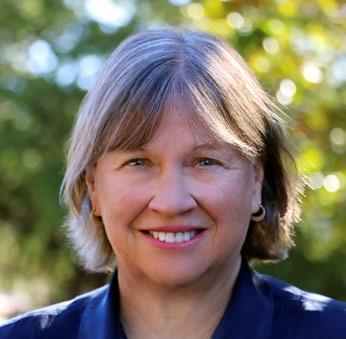
Sociologist Receives Lifetime Achievement Award for Education Research
Emerita Professor Wins 2024 Pulitzer Prize in History
Emerita professor of history Jacqueline Jones won the 2024 Pulitzer Prize for her book No Right to an Honest Living: The Struggles of Boston’s Black Workers in the Civil War Era (Basic Books). The book examines how Black workers were systematically denied access to skilled trades, factory work, and public works projects, revealing the stark contrast between Boston’s antislavery reputation and its treatment of Black residents. The Pulitzer committee lauded her work as a “breathtakingly original reconstruction of free Black life in Boston” that transforms our understanding of the city’s complex abolitionist legacy.
This is Jones’ third Pulitzer recognition, following two previous finalist nominations, and adds to her distinguished career honors, which include a MacArthur Fellowship and membership in the American Academy of Arts and Sciences.
The American Sociological Association has awarded its highest honor in education research to Chandra Muller, professor of sociology at UT Austin, whose groundbreaking studies examine how schooling shapes life outcomes across decades. Muller received the 2024 Willard Waller Award for lifetime achievement in sociology of education research. Muller currently leads two major longitudinal studies tracking high school students into later life, including a $50.3 million National Institute on Aging project — the largest grant ever awarded to UT’s College of Liberal Arts. Her research has significantly advanced understanding of educational disparities related to gender, race, ethnicity, social class, disability, and immigration status, while influencing both academic scholarship and policy development.
Inaugural Arrow Prize Goes to UT Austin Economist Research that fundamentally reshapes how we understand pricing, regulation, and taxation has earned UT Austin economics professor Vasiliki Skreta the inaugural Arrow Prize from Econometrica, one of the field’s most selective journals. The biennial prize recognizes the best economic theory paper published in the journal over a four-year span. Skreta and Columbia University professor Laura Doval were honored for their 2022 paper “Mechanism Design with Limited Commitment,” which offers powerful new insights into how markets and policies evolve over time. The prize is named for Nobel laureate Kenneth Arrow and aims to encourage high-quality theoretical contributions to economics.
Diehl Prize Supports Student’s International Education Mission
The University of Texas at Austin awarded its 2024 Randy Diehl Prize to psychology and rhetoric double major Neerul Gupta for her commitment to postgraduation public service. The selective, merit-based award recognizes graduating College of Liberal Arts seniors dedicated to serving the greater good. A member of both the Liberal Arts Honors and the Dedman Distinguished Scholars programs, Gupta will use the prize to support her year teaching English to underserved students in Madrid through the Council on International Educational Exchange. The award will allow her to focus fully on teaching and volunteer with education nonprofits rather than seeking supplemental employment.
Government Professor Named to AAAS Professor of government Christopher Wlezien has been elected to the American Academy of Arts & Sciences (AAAS), one of the country’s oldest and most prestigious scientific societies. A first-generation college student, Wlezien joined the faculty at UT Austin in 2013 and is known for developing the “thermostatic” model of public opinion and policy. He has also made significant contributions to understanding electoral systems, policy responsiveness, and the role of mass media in public policy engagement. His current research examines how political institutions influence electoral preferences across more than 300 elections in over 40 countries.
UT Austin Scholars Win Fulbright Awards to Study Climate Crisis and Wildlife Parasite Ecology
Linguist and Philosopher Awarded Schock Prize Hans Kamp, professor at the University of Stuttgart and UT Austin, has been awarded the 2024 Rolf Schock Prize in Logic and Philosophy, sharing the honor with MIT’s Irene Heim. The prize, awarded every three years by the Royal Swedish Academy of Sciences and the Schock Foundation, recognizes the scholars’ independent contributions to dynamic semantics in natural language. A pioneer in logic, linguistics, and philosophy of language, Kamp is renowned for developing Discourse Representation Theory.
National Endowment for the Humanities Awards Major Grants to Two Faculty Members
The National Endowment for the Humanities has awarded grants to two UT Austin researchers for groundbreaking projects on Black history. Associate professor Danielle Clealand will create an open-access digital archive documenting Black Cuban immigrants’ experiences from 1959-1980, exploring how they navigated discrimination in Miami. Associate professor Ashanté M. Reese’s “The Carceral Life of Sugar” will investigate connections between the Imperial Sugar Company of Sugar Land, Texas, and the prison system, sparked by the 2018 discovery of 95 unmarked prisoner graves. Both projects aim to illuminate overlooked aspects of Black history and experience in America through innovative research approaches.
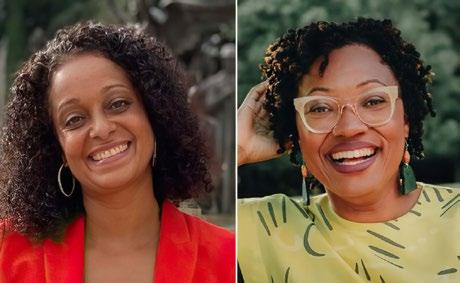
Professors J. Brent Crosson and Anthony Di Fiore have received Fulbright U.S. Scholar awards for 2024-25. Crosson will study the Caribbean’s role in climate crisis history at the University of the West Indies, while Di Fiore will research primate microparasites in Ecuador’s Amazon rainforest, focusing on wildlife disease transmission between humans and animals. Danielle Clealand, associate professor of Mexican American and Latina/o studies, and Ashanté M. Reese, associate professor of African and African diaspora studies.
Jacqueline Jones, emerita professor of history at UT’s College of Liberal Arts.
RESEARCH NEWS
ENDANGERED LEMUR SHOWS RESILIENCE TO DROUGHT CONDITIONS
Verreaux’s sifaka, a critically endangered species of lemur found in the seasonally dry tropical forests of western Madagascar, demonstrated remarkable resilience to long periods of drought and resource scarcity, according to a 13-year study published in Integrative Conservation by scientists at The University of Texas at Austin, Midwestern University, and University of Arizona, Tucson.
Working in Madagascar’s Ankoatsifaka Research Station from 2010 through 2023, the team collected data on rainfall, tree survival, and the availability of the sifaka’s major food sources (tree leaves, flowers, and fruit). For this same time period, they observed sifaka feeding behavior and measured their weight, body mass index, and subcutaneous fat levels as well as their rate or reproduction and infant survival.
suffer. We studied a species that experiences extreme seasonal variation in resources every year and found that they weren’t really worse off during times of severe drought,” says Lewis. “What this means is that as we attempt to understand and plan for how the world is changing due to global
warming, it is important to keep in mind that not all species react the same to increasingly harsh environments.”
The authors note that, in the long run, the sifaka’s adaptations may not be enough to assure their survival in the face of increasing
extreme weather events, along with other threats such as deforestation and poaching. But for the moment, their ability to adapt to drought may protect them from the negative effects of climate change.
“This started out as a project exploring the effects of drought on sifaka health,” says lead author Carrie Veilleux, who earned her Ph.D. at UT Austin and is now assistant professor of anatomy at Midwestern University.
“I expected to see their health decline during drought periods, so it was really surprising that not only did their health not decline, but the sifaka actually got fatter!”
This increase in fat was due to a change in the sifaka’s eating behavior exhibited during drought years. As trees withered during long dry periods, the sifaka consumed fewer leaves and instead focused their foraging on trees’ fruit and flowers, an adaptation that allowed them to survive despite the scarcity of water.
“There weren’t more fruits or flowers available during the drought, so the lemurs were clearly seeking out these sugar- and waterrich foods,” explains Rebecca
The researchers found that during three years of severe drought during the study period, the sifaka not only maintained their weight and health but also increased their subcutaneous fat levels.
Lewis, professor of anthropology at UT Austin and co-author of the study. “Why do they normally eat leaves instead of fruits and flowers? Why make this dietary switch during droughts? We think that they are putting on the fat as a means of storing water rather than for storing energy.”
The study also found no negative impacts on sifaka reproductive output or infant survival during severe drought.
In normal years, the sifaka’s environment experiences seasonal dry periods between June and November. This regular variation in resource availability may have led to the adaptive behaviors that helped them weather longer spells of scarcity. As extreme weather events such as droughts increase, the sifaka’s adaptive strategy may help them survive amidst changing conditions.
“Most of the time when we think about animals experiencing severe drought in their habitats, we think that they surely must really

A Verreaux’s sifaka. Photo by Rebecca Lewis.
RESEARCHERS USE AI TO TURN SOUND
RECORDINGS INTO ACCURATE STREET IMAGES
Using generative artificial intelligence, a team of researchers at The University of Texas at Austin has converted sounds from audio recordings into street-view images. The visual accuracy of these generated images demonstrates that machines can replicate human connection between audio and visual perception of environments.
In a paper published in Computers, Environment and Urban Systems, the research team describes training a soundscape-to-image AI model using audio and visual data gathered from a variety of
urban and rural streetscapes and then using that model to generate images from audio recordings.
“Our study found that acoustic environments contain enough visual cues to generate highly recognizable streetscape images that accurately depict different places,” says Yuhao Kang, assistant professor of geography and the environment at UT and co-author of the study. “This means we can convert the acoustic environments into vivid visual representations, effectively translating sounds into sights.”
Using YouTube video and audio from cities in North America, Asia, and Europe, the team created pairs of 10-second audio clips and image stills from the various locations and used them to train an AI model that could produce high-resolution images from audio input. They then compared AI sound-to-image creations made from 100 audio clips to their respective real-world photos, using both human and computer evaluations. Computer evaluations compared the relative proportions of greenery, buildings, and sky between source and generated images, whereas human

judges were asked to correctly match one of three generated images to an audio sample. The results showed strong correlations in the proportions of sky and greenery between generated and real-world images and a slightly lesser correlation in building proportions. And human participants averaged 80% accuracy in selecting the generated images that corresponded to source audio samples.
“Traditionally, the ability to envision a scene from sounds is a uniquely human capability, reflecting our deep sensory connection with the environment. Our use of advanced AI techniques supported by large language models demonstrates that machines have the potential to approximate this human sensory experience,” Kang says. “This suggests that AI can extend beyond mere recognition of physical surroundings to potentially enrich our understanding of human subjective experiences at different places.”
In addition to approximating the proportions of sky, greenery, and buildings, the generated images often maintained the architectural styles and distances between objects of their real-world image counterparts, as well as accurately reflecting whether soundscapes were recorded during sunny, cloudy, or nighttime lighting
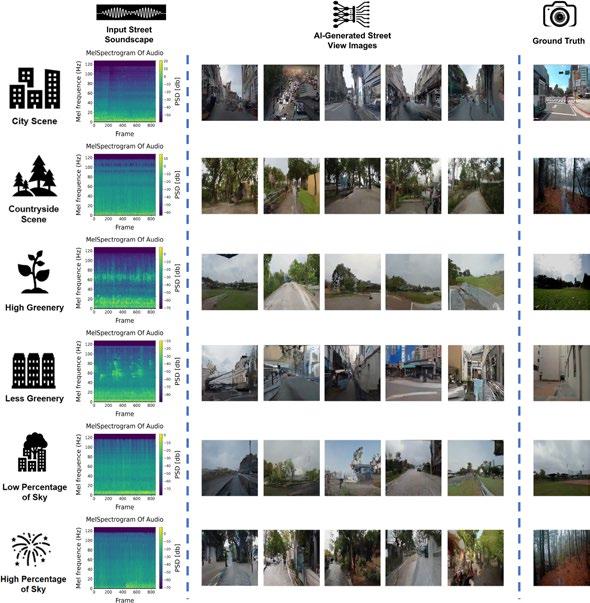
conditions. The authors note that lighting information might come from variations in activity in the soundscapes. For example, traffic sounds or the chirping of nocturnal insects could reveal time of day. Such observations further the understanding of how multisensory factors contribute to our experience of a place.
“When you close your eyes and listen, the sounds around you paint pictures in your mind,” Kang says. “For instance, the distant hum of traffic becomes a
bustling cityscape, while the gentle rustle of leaves ushers you into a serene forest. Each sound weaves a vivid tapestry of scenes, as if by magic, in the theater of your imagination.”
Kang’s work focuses on using geospatial AI to study the interaction of humans with their environments. In another recent paper published in Nature, he and his co-authors examined the potential of AI to capture the characteristics that give cities their unique identities.
Sample street view images in the three groups (urban vs. rural; high and low greenery; high and low sky visibility). Image courtesy of Yuhao Kang.
DIGITAL THERAPY VIA SMARTPHONE IS COST-EFFECTIVE
For patients across the world with generalized anxiety disorder (GAD), the treatment of choice is Cognitive Behavioral Therapy, or CBT. But accessing therapistprovided CBT can be prohibitively difficult, and many individuals with an anxiety disorder do not receive adequate treatment. This results in a lower quality of life for patients as well as an economic burden for both individuals and their employers. A new study from university researchers has identified a promising solution: fully automated digital CBT provided via smartphone.
The study, recently published in PLOS Mental Health and funded by Big Health, the developer of digital CBT program Daylight, modeled anxiety treatment for 100,000 patients in the United States. The international and interdisciplinary research team behind the study — including UT Austin professor of psychology Jasper Smits — found that automated digital CBT was costeffective and cost-beneficial for both private payers and society at large. In fact, when measured against other treatment options for general anxiety disorder, including medication and therapist-delivered CBT as well as no treatment, their model
AND BENEFICIAL
identified automated digital CBT as the most cost-effective.
“The results showed that Daylight had similar benefits to therapistdelivered CBT but at a lower price and that it generated more value than medications due to strong clinical benefits and reduced need for ongoing anxiety management visits,” says Smits. “Individual CBT has been identified as a firstline treatment option for GAD, so we were comparing digital CBT here to a really efficacious standard in the field.”
To establish the cost-effectiveness of treatment options for GAD, the researchers first calculated the total cost of each option as well as the costs of living with an anxiety disorder both for patients and for their employers. These costs can be substantial: total direct medical costs associated with GAD has been estimated to be around $38 billion a year, and workers with GAD may require more healthcare spending and take more sick days, driving up total costs. The researchers also accounted for the ability of various treatment options to improve patients’ overall quality of life.
In their model, which tracked 100,000 patients for 12 months,
digital CBT was found to have the lowest overall cost and to be as effective as other, more expensive forms of CBT in improving patient quality of life.
“The cost-effectiveness of Daylight is striking,” says Michael Darden, the lead researcher on the study and an associate professor of economics at Johns Hopkins University. “Under a range of treatment effect assumptions, our economic modeling shows that Daylight may provide considerable value to the healthcare system. This could have major implications for how we allocate resources in mental health care.”
The researchers say their study should encourage healthcare providers to consider digital CBT for patients with anxiety. Doing so would make CBT more accessible and affordable, with significant benefits for individual patients and for society more generally.
“Our findings demonstrate that digital CBT offers a highly effective and accessible treatment option for generalized anxiety disorder,” says Smits. “This has the potential to significantly expand access to evidence-based care for those who do not want traditional therapy.”
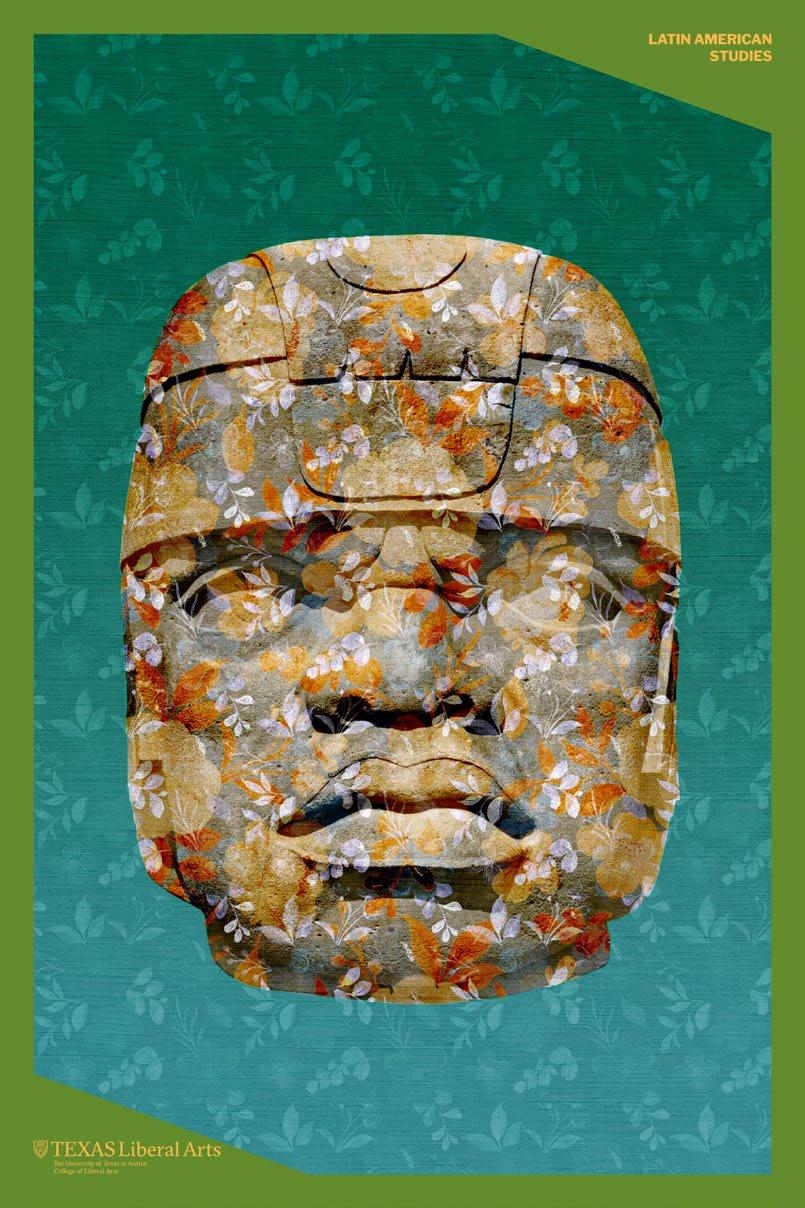

The posters you’ll see throughout the magazine are part of a larger forthcoming project by artist Dave McClinton that will feature a poster for each department and select interdisciplinary programs in UT Austin’s College of Liberal Arts. The posters will be displayed in the Dorothy Gebauer Building. Stay tuned for information about the opening.
RECRUITMENT SEASON
By Daniel Oppenheimer
Oneof the most fundamental dilemmas I face as head of communications for the College of Liberal Arts is that many of our undergraduates didn’t choose to be here. Right now, about half of the students in each incoming class identified our college as their first or second choice when they applied to UT Austin. They want to be here, in other words, and not just at UT. The other half of our first-year class didn’t list us as a preferred college, but decided to come here anyway because they want to be at UT.
We’re happy to have these students, of course, and in fact their presence is a significant factor in why our college of liberal arts hasn’t seen the same drastic declines in certain majors as many of our peer institutions. From a brand perspective, though, this is not an ideal situation. It’s also not ideal for the students themselves, who (according to a recent analysis we conducted) are 16% less likely to graduate in four years than the students who chose specifically to be here.
Because of the way UT Austin admissions work, we’re always going to have some of these students. There is the potential, however, to drive up both the number of overall applicants who are interested in the liberal arts and the number of admitted liberal artsoriented students who choose to matriculate to UT. Moving the needle on either of these numbers would result in a college with more students who really want to be here. That would be good.
This is the background to a campaign we’ve been developing to market the college to both prospective and admitted-but-not-yetmatriculated students. We’re far enough along that I can share some initial concepts with you as well as the fruits of the research that went into developing our campaign.
The research had three main elements. I did a scan of how other universities are pitching themselves to prospective students. I conducted small, informal focus groups with students and relevant staff
and leadership. And I just lived my life as the father of a daughter in her senior year of high school, watching the flood of mailings and emails pass through her inbox and our mailbox (usually on the way to the real and virtual trash).
The global takeaway from each path of inquiry was the same: It all kind of blends together after a while. Colleges and universities are all drawing from the same bucket of core themes: connection, opportunity, warmth, selfdevelopment, tradition, innovation. We all feature the same kind of photography of happy and engaged students, passionate-looking teachers, and idyllic campus landscapes. We’re all telling versions of the same story, which is that you should come to our school to discover yourself and build your exciting future.
I don’t take this to mean that there’s no point in doing such marketing, but it’s useful to have this broad view in mind. It helps to clarify what the point is and what a set of realistic expectations should be. For
lesser-known schools, the goal may be to put yourself on the radar of students who otherwise wouldn’t know about you. For many of the elite schools, it’s clearly to artificially juice their selectivity by driving up applications from students who have little chance of getting in.
For every school, of course, the point is to increase applications and matriculations, but there are other goals as well. It’s our first communication with the students who will eventually attend our school, and it’s an opportunity to get them excited about and acculturated to our community. There’s also the much longer-term project of developing and reinforcing loyalty to the institution that will persist beyond graduation..
So the marketing matters, if often at the margins, and it’s interesting to observe how schools sell themselves. A&M
is warm and familial (“Join the Aggie Family”). MIT’s main admissions site is a feed of blog entries from current students, each of whom gets a cute custom illustration. Sewanee sells the natural beauty of its environs. Texas Tech is selling tradition and spirit (“Be a Part of the Legacy”). If I had to characterize our current prospective student landing page, which features the tag line “Choose COLA,” I’d say it’s pretty median: bright and colorful, happy students, cool-sounding classes, etc. Its message is that this is a place where students are engaged and upbeat.
Our prospective student brochure features the tagline “Your Story Starts Here,” and the vibe is communal and warm. This is a place, it’s conveying, where you can find yourself, where you’ll have support, and where your
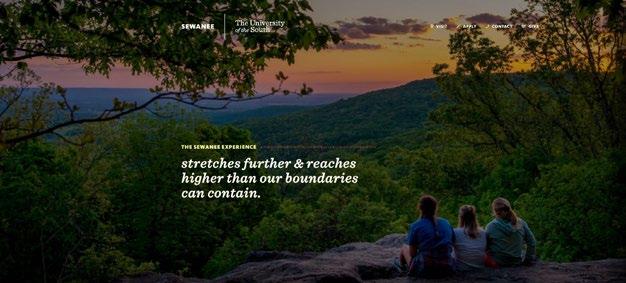
experience is valued. It’s a beautifully designed brochure, and the message is a solid one, but the tone is a bit softer than what we plan to implement. The conclusion we’ve come to is that we need to increase the emphasis on achievement and ambition in order to better compete for students who might otherwise choose a STEM discipline, a business degree, or a liberal arts degree at another college or university.
The heart of our new campaign is what I’m calling, informally, the wheel of destiny. You can see one iteration of it, “For Future Leaders,” in the graphic above. The point of the wheel is that it can land on many different futures, depending on each student’s interests and talents. Whatever your destiny, in other words, the College of Liberal Arts is here to help you discover it and then give you the skills and support to launch into it. We’re large and many-splendored and dynamic and well-resourced.
We’re not laboring under the illusion that this is a oncein-a-generation marketing concept. Our sense is that it’s a good one, and that it will serve to anchor a more strategic, more coordinated set of communications across the varied platforms. We’ll produce a video, a social

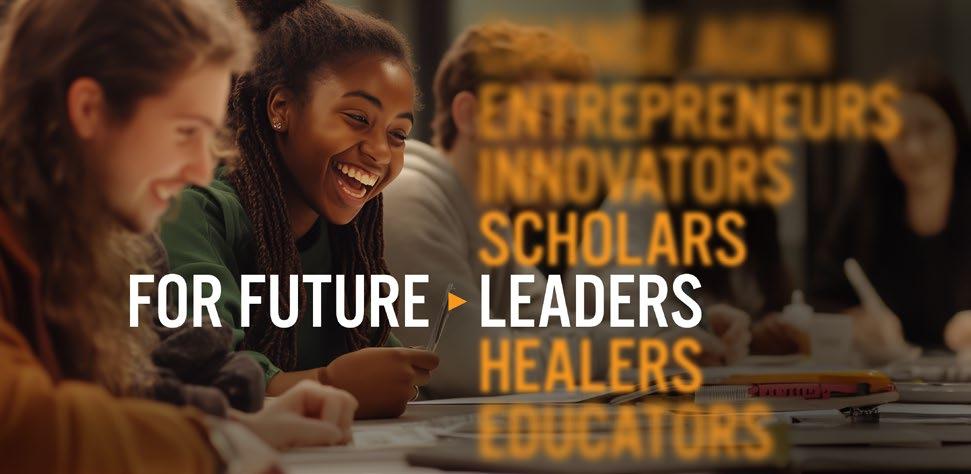
media campaign, a new brochure, email graphics, etc., and it will give more efficacy and consistency to both our prospective student campaign and our communications with current and former students.
It’s often the case, in branding and marketing, that simply having a consistent message across platforms and repeating it over time is more important than optimizing for the most brilliant message. Repetition and consistency tend to prevail over an extra 4% of creativity.
That said, if you’ve got a brilliant idea, please share it with me. My inbox is open: oppenheimer@utexas.edu.
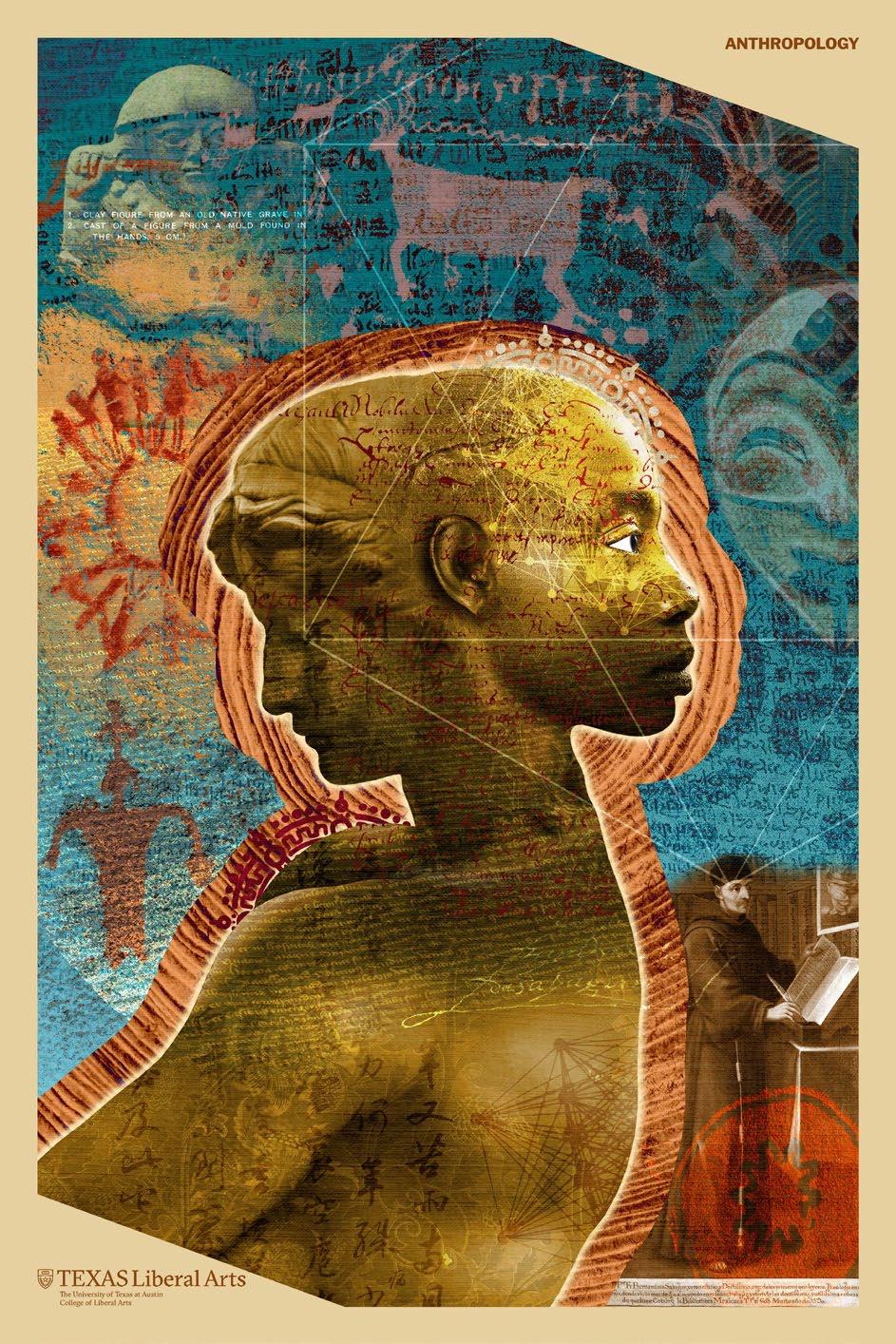

The vibe on the A&M admissions page is warm and familial.
The AI students in this image will be replaced with real UT students.
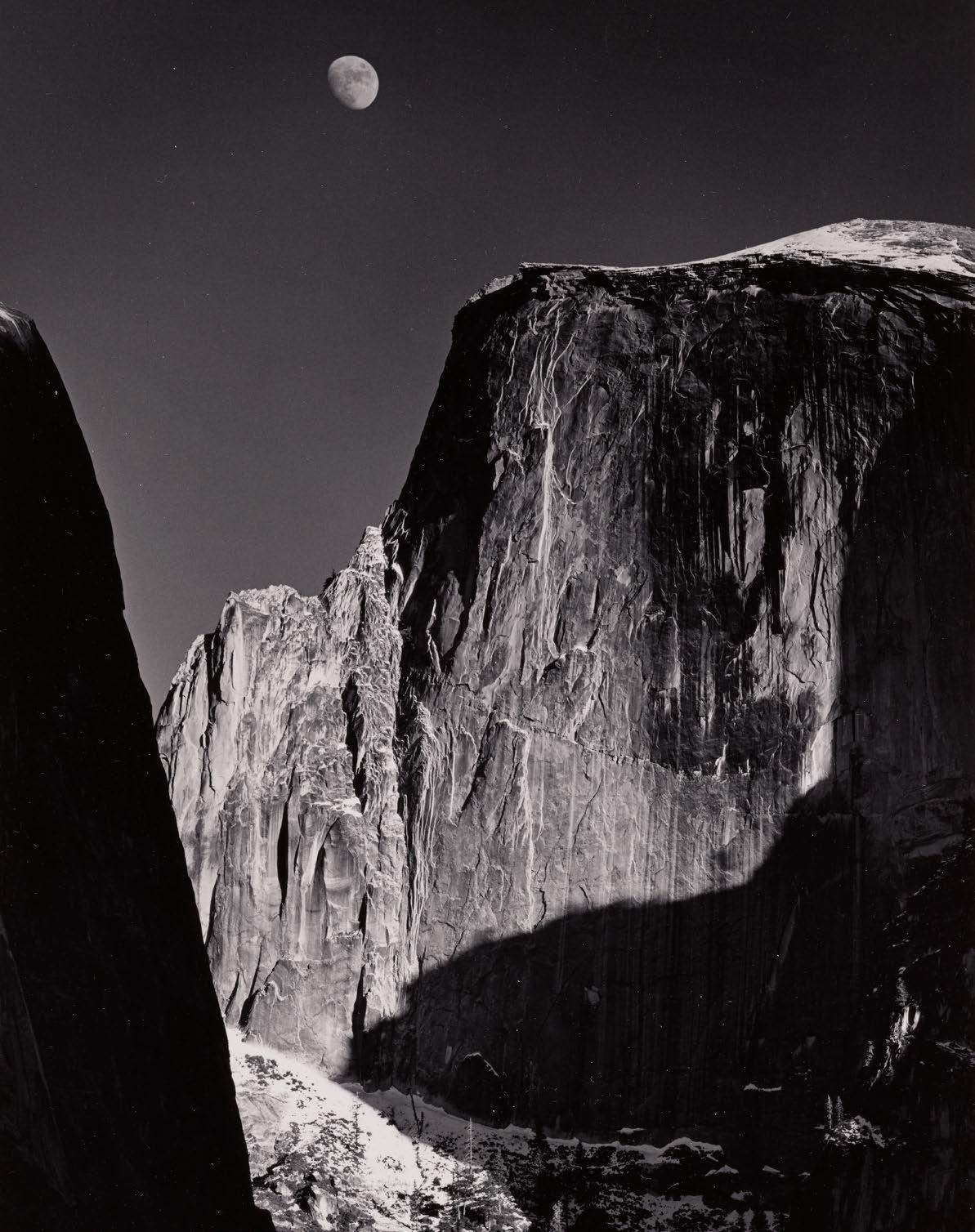
Ansel and Me
An American studies professor’s adventures in curating
BY STEVEN HOELSCHER
The first time I encountered the photography of Ansel Adams wasn’t in a museum gallery but during a college course. I remember the moment well. The course, “Wilderness and the American Mind,” introduced me to a wide range of memorable texts. In good American studies fashion, we dove into writing by Thoreau, Willa Cather, Rachel Carson, William Cronon, and more — and also the photography of Ansel Adams.
As much as anything that I read in that course, the 35 mm slides that I viewed affected me in far-reaching and unpredictable ways. I became aware, probably for the first time, of photography as an art form. I was seeing images that inspired me and made me want to explore the natural world in a way that art previously hadn’t.
I’ve learned a lot about Ansel Adams since “Wilderness and the American Mind,” and I have a much better sense of why his photographs moved me so profoundly. I understand how his work both fit into the canon of photographic history and served as an inspiration for the environmental movement. And I’ve seen the magical power of Adams’ original prints: how they, more than any other format, present his photographic images in exquisitely wrought detail that demand attention.
Over the past year, in my role as faculty curator of photography at the Harry Ransom Center, a major humanities research center and museum here at UT Austin, I’ve worked to put together
“Visualizing the Environment: Ansel Adams and His Legacy.” During the process of curating this exhibition, I’ve often reflected on the experience of conceiving, researching, and mounting pictures. While I’m familiar with the role of critical scholar from my faculty position in the Department of American Studies, curating is relatively new for me. I’ve found that creating an exhibition is a lot different than critiquing it.
From the beginning of the curating process, when I began reviewing all the prints by Adams that we had at the Ransom Center, several specific themes emerged, including Adams’ change over time as he developed as a photographer, the powerful sense of place he felt in Yosemite, and the role of photographs in environmental conservation. Other themes began to emerge as I dug deeper into the center’s photography collections. It became clear that Adams’ belief in the power of photographic visualization to inspire reverence for the natural environment set him apart from most of his 19th- and early-20th-century precursors, whose photographs often focused on presenting views of the landscapes for corporate or governmental interests. Other photographers, especially those connected to the important journal Camera Work (1903-1917), presented photography as a fine art, but they did so from different aesthetic perspectives.
For photographers who have come after Adams, his legacy looms large, and for many contemporary photographers it represents both a debt and a burden. The photographer Mark Klett, for example, describes how Adams helped raise environmental consciousness and prove that photography could be a powerful medium for that project. At the same time, by removing evidence of the human impact on the earth, Adams presented a romanticized vision of a lost world. As Klett puts it, “The landscape is not so much a paradise to long for (some say a paradise lost), as it is a mirror that reflects our own cultural image.”
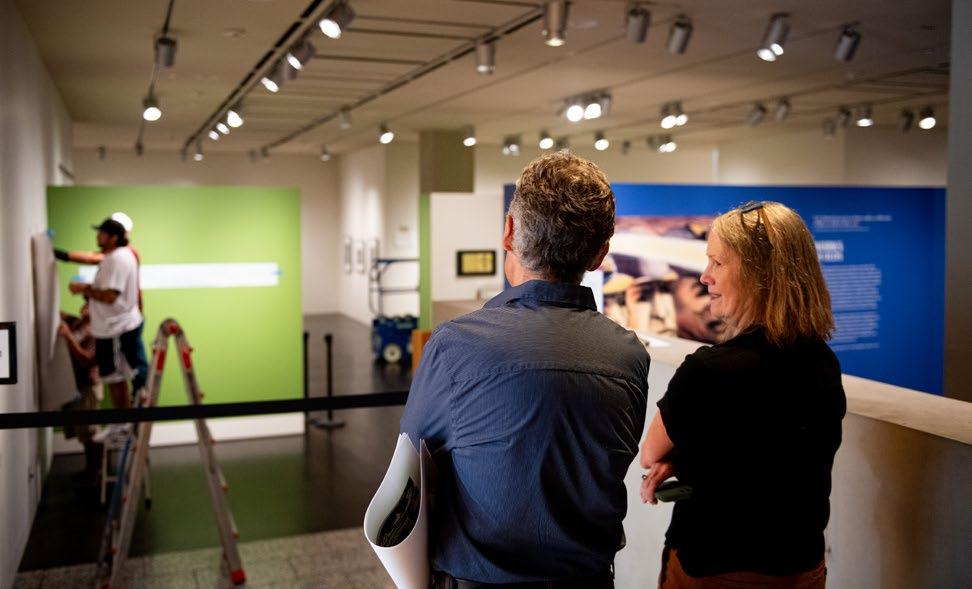
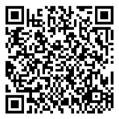
The resulting exhibition explored both Adams’ work and that of the photographers who came before and after him. I ultimately selected nearly 100 objects to be included in the exhibition and, together with the Ransom Center’s preservation and conservation teams, made decisions about how to present each photograph and where it would be placed in the gallery. The “identity” of the exhibition began to take on firm shape as the Ransom Center’s creative director, Leslie Ernst, helped me think through the interplay of images, colors, fonts, and layout of wall texts. I also considered the materials that would extend the reach of the exhibition beyond the gallery. With the assistance of Stephanie Zeller, a graduate student in UT’s Department of Geography and the Environment, we created an online GIS story map to accompany the exhibition. By mapping and generating three-dimensional renderings of the sites of many
of the photos in the exhibition, it gives viewers a sense of what the landscape might have looked like to the photographers.
The installation process itself was an enormous task, with the inevitable hiccups and unexpected complications. For the better part of two weeks, at least twice each day I visited the galleries as the exhibition came together, making final decisions about object placement and text revisions. The entire experience felt like a three-dimensional set of page proofs that authors receive from publishers; it’s both your last chance to make modest corrections and where all the hard work becomes real.
The exhibition opened in late August 2024 and ran through February of this year. Dozens of university classes visited every week and, I was told, attendance for exhibitions at the Ransom Center went
up 110%. It’s humbling to realize that, as measured by public engagement, organizing this exhibition will probably be more impactful than any book, article, or chapter than I’ve ever written.
As my experience over the past year has demonstrated to me, organizing an exhibition at a place like the Ransom Center is itself a form of scholarly activity. Even if that work does not appear in one of the data platforms that are often used to measure faculty productivity, the creative, logis-
tical, and intellectual labor necessary to produce an exhibition is substantial and should be recognized as such. This kind of public humanities work is also deeply collaborative. The number of people who contributed to this exhibition is staggering, and never have I worked so closely with so many ultra-competent and devoted colleagues dedicated to enlightening, engaging, and inspiring as many people as possible. For me, this experience has been a career highlight — and it’s all thanks to Ansel Adams.
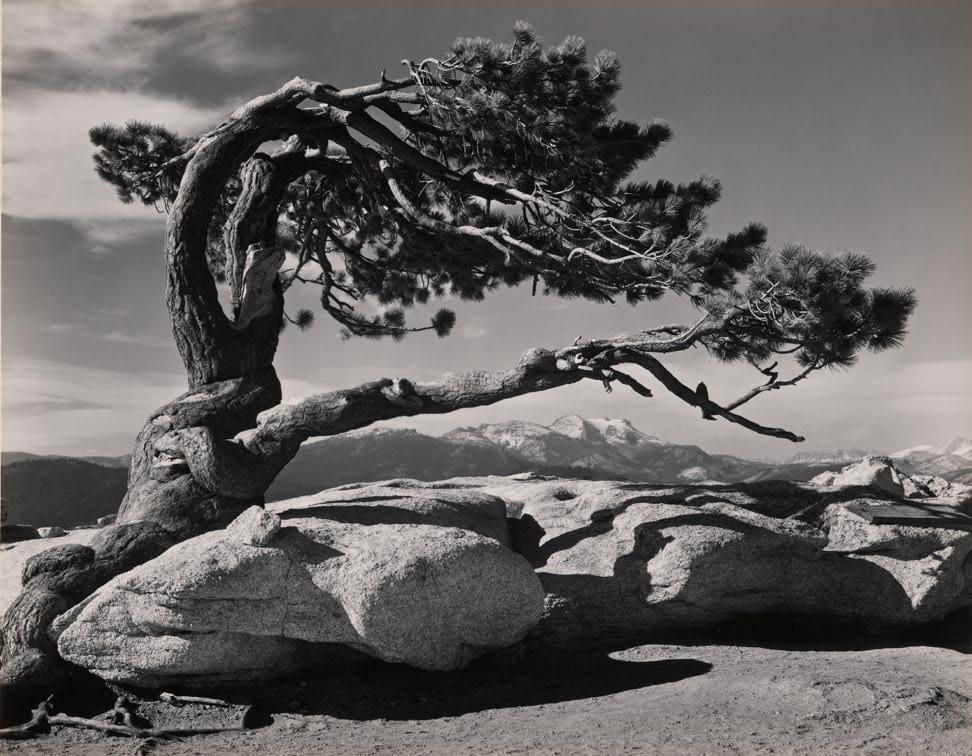
Steven Hoelscher (left) and Ransom Center creative director Leslie Ernst supervise the installation of “Visualizing the Environment.”
Photo by Ashley Park.
Ansel Adams (American, 1902–1984), Jeffrey Pine 1945; Yosemite Special Edition Print ca. 1970. Gelatin silver print, 17.9 x 23 cm (image).
Harry Ransom Center, Photography Collection, gift of Stephen and Joyce Latimer Hunt, 2015:0036:0007. © Ansel Adams Publishing Rights Trust.
Steven Hoelscher is professor of American studies, associate dean for academic affairs for the College of Liberal Arts, and faculty curator for photography for the Harry Ransom Center.

HIKES FOR TYKES
There is a pretty direct line, or maybe we should say a not-so-direct line, between the work that sociologist Nina Palmo does at The University of Texas at Austin as an assistant professor of instruction and her new book. On campus, she teaches courses on topics like “Health and Society” and “Economic Sociology of Health.” In her book, she spreads the gospel of health and nature to the families of Texas. 50 Hikes with Kids Texas, published last year by Timber Press, highlights the most kid-friendly hikes in the Lone Star State, including the one-mile hike in Big Bend below. The book includes all the essential details, including the length of hike, the elevation you’ll have to cover, nearby bathrooms, and where you can go to get the kids a snack.
Who’s Counting?
Anat Schechtman on non-quantitative notions of infinity
By Alex Reshanov
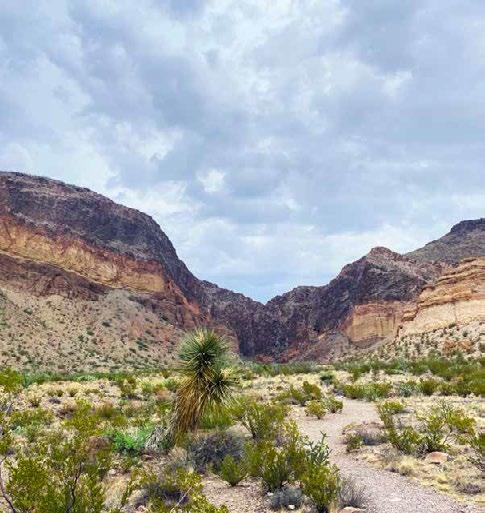
The German mathematician David Hilbert proposed a thought experiment about a hotel with an infinite number or rooms. Even at full capacity — its infinite rooms occupied by infinite guests — the hotel could always accommodate more. If, say, four new guests arrived, the hotel would move each of its existing guests to a room four numbers higher. The guest in room one would move to room five, room two to room six and so on, freeing up rooms one through four for the newcomers. Impressively, the hotel could even find space for an infinite number of additional guests. In this case it would move its existing guests to the double of their current room numbers (one into two, two into four, etc.), thus freeing up all the odd numbered rooms, an infinite amount of them. A clever system if we overlook the inevitably high turnover rate among the cleaning staff.
I describe Hilbert’s hotel to demonstrate two points. The first is that pondering infinity is entertaining, at least if you’re
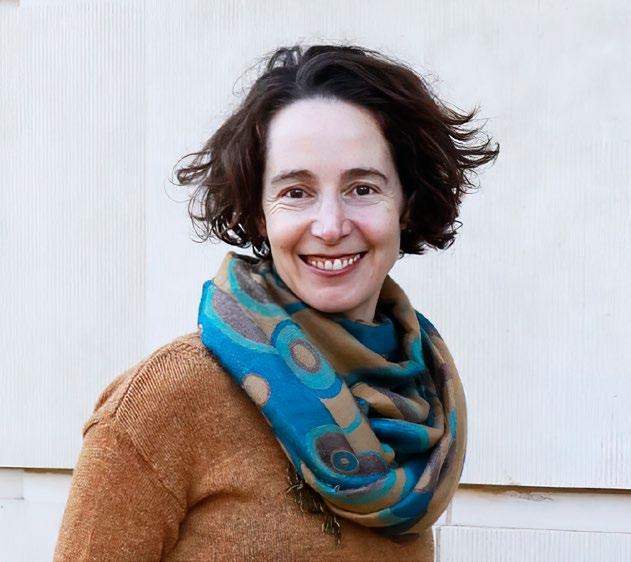
the type who enjoys brain teasers and paradoxes (and if you’re not, I probably lost you at “German mathematician”), and the second is that discussions of infinity often focus on quantity. Whether it’s the infinite years of eternity, the infinite space of our boundless universe, or the infinite amount of shrimp Red Lobster audaciously promised you could receive for only $20, we tend to think about infinity as a limitless amount of something.
But according to associate professor of philosophy Anat Schechtman, there are multiple ways to conceive of infinity, and
some have nothing to do with counting. Schechtman — who specializes in early modern philosophy, a period encompassing the 17th and 18th centuries that gave us influential thinkers like Descartes, Locke, and Kant — is writing a book on notions of infinity from this era and has uncovered several distinct philosophical approaches. Some will be familiar to contemporary sensibilities while others require us to stretch our imaginations...
Continue reading at https://lifeandletters.la.utexas.edu/2025/01/ whos-counting/
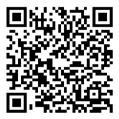
by Nina Palmo and Wendy Gorton, photographs by Wendy Gorton.
Associate professor of philosophy Anat Schechtman. Photo by Alex Reshanov.
make parents proud and those that horrify them).
THE MENTOR MINDSET
PSYCHOLOGY PROFESSOR
DAVID YEAGER ON HOW TO SPEAK SO YOUNG PEOPLE WILL LISTEN
By Imani Evans
If the headlines are to be believed, it’s never been harder to motivate young people. The reasons abound: they’re too soft, too sensitive, too overwhelmed, too entitled, too stressed, too social mediaaddicted, too lacking in work ethic.
Psychology professor David Yeager takes on these contentions and more in his new book, 10 to 25: The Science of Motivating Young People (Simon & Schuster, 2024).
“The idea for this book grew out of a simple observation I made about a decade ago,” writes Yeager in the introduction, “that many beloved programs to promote youth health and well-being were shockingly ineffective.”
Yeager’s work belongs to the intellectual lineage of books like Angela Duckworth’s Grit,
Carol Dweck’s Mindset, and Mary Murphy’s Cultures of Growth. His major purpose is to lay bare the secrets of what he calls the “mentor mindset,” with its careful balance between high standards and support. The book provides numerous examples of mentor mindset in action, through profiles of successful coaches, managers, teachers, and parents who — sometimes after trying other approaches that didn’t work so well — learned how to get the best from their pupils or mentees.
The “10 to 25” in the title refers to the age range during which, Yeager argues, puberty-linked changes in the brain start to cause the palpable status anxiety we see in teens. Yeager defines status in terms of young people’s longing for prestige, a kind of social currency that young people gain through impressive acts (both those that
Yeager sympathizes with parents — after all, he is one. But, he argues, parents will flail when not taking into consideration young people’s desire for status and respect. Importantly, both authoritarian and permissive parenting styles suffer from this basic flaw.
“Any time young people interact with socially powerful people — managers, parents, educators, or coaches — status and respect come to the foreground,” Yeager writes early in the book. “Because young people feel sensitive to differences in status, they are subtly reading between the lines with each thing we say, trying to interpret the hidden implications of our words, to find out if we are disrespecting or honoring them.”
Why is it so important to understand motivation in young people? Most obviously, the stakes are high. They include, for instance, young people’s academic achievement, future job prospects, and emotional well-being. Sadly, young people will often follow adults’ lead by either underestimating themselves or seeing themselves as broken when they struggle.
The principal adversary in this story is what Yeager calls the
“neurobiological incompetence model” of adolescence. It’s a familiar story: young people’s underdeveloped brains are what cause them to behave impulsively and make poor choices. The model has evidence behind it, including an abundance of neuroscientific findings that the prefrontal cortexes of young people, crucial for decision-making and planning, are still developing.
Unfortunately, argues Yeager, it doesn’t tell the whole story, and it leads to two faulty approaches to young people. One is what he calls the “enforcer mindset,” which is oriented around the threat of consequences for not meeting a given expectation. If a young person’s brain is underdeveloped, what’s the point of reasoning with them? The other is the “protector mindset,” which is sort of the opposite. It prioritizes young people’s self-esteem at the expense of real flourishing.
The mentor mindset, on the other hand, strikes the right balance. Yeager writes, for instance, of a group of students assigned a history project that involved interviewing surviving
World War II veterans. There were real stakes to doing a good job; these were veterans whose stories have never been told, and the students were entrusted with capturing those stories faithfully.
“The Enforcer or Protector would never consider giving that kind of assignment,” says Yeager. “Because the Enforcer thinks that young people are only responsive to material incentives or threats of punishment. That’s why the Enforcer walks around yelling at everybody, threatening them, or bribing them.”
The protector mindset fails by coddling young people, says Yeager. “When you’re the Protector you’re like, ‘Oh, no, your life is too hard. I can’t ask you to put the weight of the world on your shoulders. It would cause you stress. It would cause you anxiety. I need to protect you until your thirties and then you can go make a difference.’”
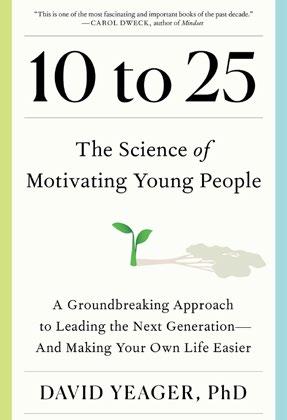
“What I argue is that the Mentor way to do it is to be like, ‘Unfortunately, the world is totally messed up, and there’s a lot of stuff wrong,’” says Yeager. “‘But you, young person, have an asset, and the asset is that moral clarity that comes from being young and seeing problems in the world, and the energy that you bring to making a difference.’” 10 to 25 is a work of social science. It is also a work of journalism. Yeager credits a friend, Austin journalist and writer Paul Tough, with nudging him in this direction.
“But you, young person, have an asset, and the asset is that moral clarity that comes from being young and seeing problems in the world, and the energy that you bring to making a difference.”
“Paul wrote a great book about higher education that features UT as a success story,” says Yeager, referring to Tough’s book The Years that Matter Most: How College Makes or Breaks Us “And I helped him a ton in that reporting.”
His friend’s story-driven approach rubbed off on Yeager.
He contrasts himself with an imagined psychologist who, writing a similar book, might only look for stories that support a predetermined conclusion. But Yeager soon realized that the story told by his science alone was insufficient.
“I actually learned a lot from these people,” says Yeager. “And I changed my hypothesis. So, it really was a theory that developed partially through experimental research and partially through a systematic approach to reporting on real people’s experiences.”
An example of one of the book’s illuminating case studies is physics teacher Sergio Estrada, who teaches at Riverside High School in El Paso. His courses are demanding, sometimes just on the verge of overwhelming his students. But Estrada engages his students around some core principles at the heart of 10 to 25. He tells them that struggles are normal and not a reflection of students’ innate ability. He delights in answering questions. He gives hard assignments and tests, but allows them to be re-done. And he makes sure his students know he will always be there for them. Faced with a frustrated student, Estrada’s approach is to coax the student to explain their thinking on a problem — not just giving them the answer — followed by
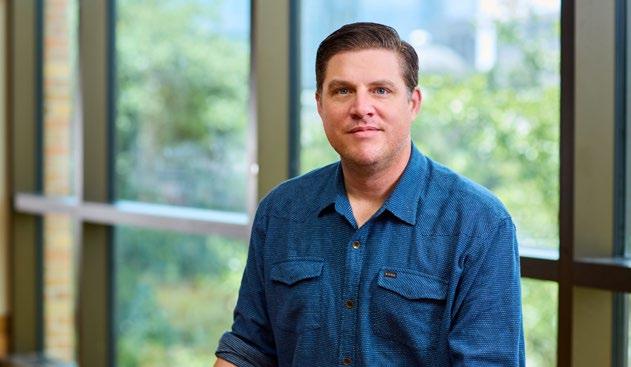
collaborative problem-solving. Through learning such challenging materials, students gain a sense of mastery and the prestige that comes with it. In a school where 2% of students are college ready, according to SAT scores, 95% of his students pass college-level physics.
But Yeager doesn’t just want a model to admire. His goal is to turn the science of youth motivation into interventions at scale. In that spirit, he launched the FUSE Fellowship at UT Austin. The two-year fellowship is a partnership between Texas math teachers and the university’s Behavioral Health Science & Policy Institute. Enrolled teachers receive coaching and exposure to science-based practices, access to the FUSE Library of Practices, and a $1,000 honorarium. Estrada is one of the facilitators.
“We have over 200 teachers and over 40 districts in our program right now, reaching about 12,000 students,” says Yeager. “And we want to be at one thousand teachers a year. My vision is for every single kid in the state of Texas to be taught by a teacher who knows the principles and practices in the book.”
The “mindset” concept has caught on further, too. Yeager just launched a course with Masterclass — the famous streaming service where anyone can subscribe to learn from the world’s leading experts — along with his longtime collaborator Carol Dweck. It’s called “The Power of Mindset.” The class is designed to help students turn challenges into growth and to optimize performance, just as it’s doing in schools across the country now.
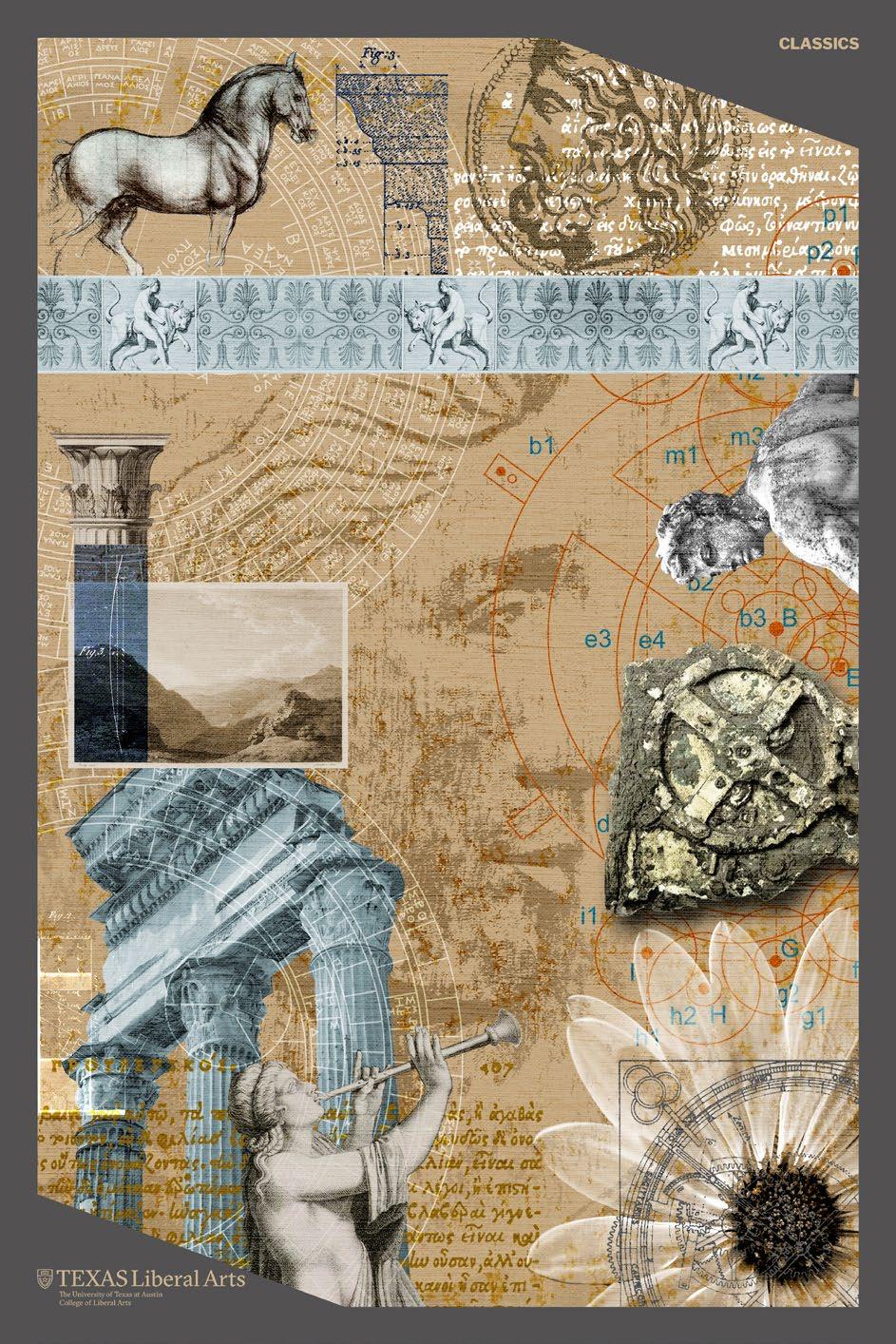

David Yeager, professor of psychology. Photo by Justin Leitner.
HOW TO THINK LIKE A ROMAN
IBy Alizeh Kohari
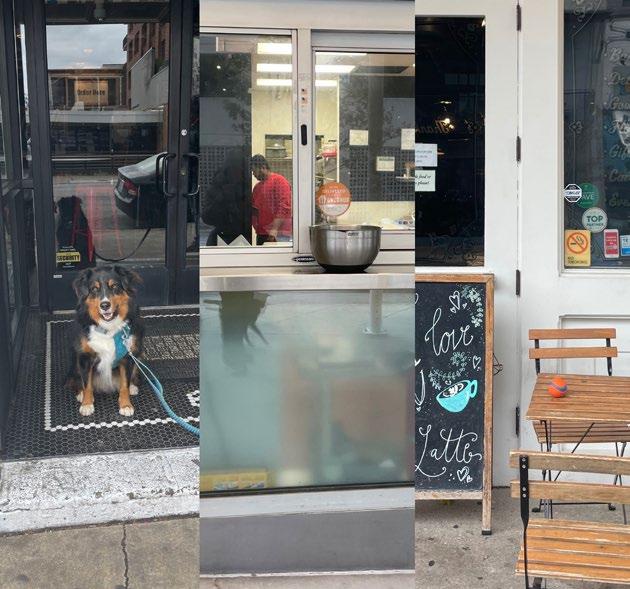
f classicist Andrew M. Riggsby had to give a speech about his dog Elmer — an extensive and rousing one that he’d need to recall without effort or external aid — he would first visualize the strip mall near where he lives.
“I’d memorize all the stores, lock that layout down in my memory,” he explains. These are his loci. “Then I’d place an image of Elmer outside the first store; that’s where I tell the audience I’m going to speak about him. The second image, in front of the second store, might be of whipped cream, because there’s this great story of him jumping up on our dining table to get into a bowl. Then maybe an image of a tennis ball because he likes to play with us...” These are Riggsby’s imagines.
What Riggsby is describing is the loci method, a millenia-old mnemonic that can help you recall pieces of information (imagines) by mentally situating them in a location (locus) that you know well. It’s how orators like Cicero and Quinitilian were able to hold forth for hours on end in high-stakes settings — funerals, political assemblies — without veering off script. The technique is well-known. You might have
Rather than togas and aqueducts and gladiatorial battles, Riggsby mostly thinks about how ancient Romans thought.
come across a version of it without even realizing it, in the TV series Sherlock or the Booker Prize-winning novel Wolf Hall. Riggsby is describing it to me, however, to make a finer point. The method, he says, is strictly useful for recalling information in a precise order, not if you’re looking to improvise a little.
It’s an argument he’s exploring in his current book project, Reading Roman Minds, an eclectic set of case studies that he describes as “an attempt to write the history of the ancient world with help from cognitive science.”
Like many men — a startling number if a viral TikTok trend from last fall is to be believed — Riggsby thinks often and at length about ancient Rome. Unlike most men, however, the
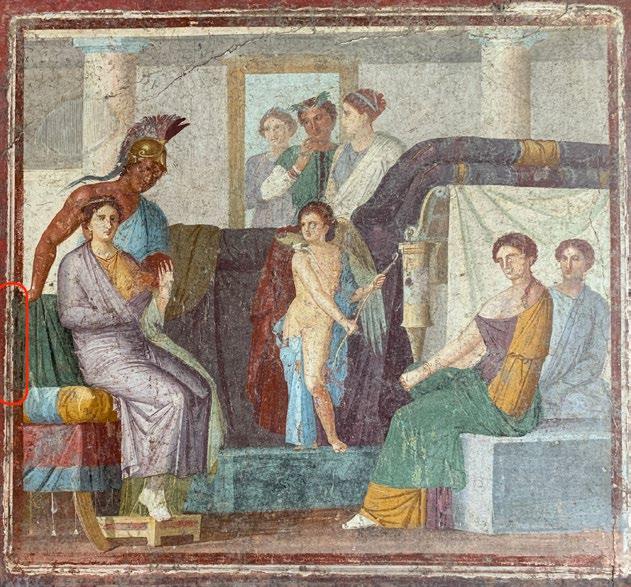
Lucy Shoe Meritt Professor in Classics (and professor of art history) has devoted his life to its study. Rather than togas and aqueducts and gladiatorial battles, Riggsby mostly thinks about how ancient Romans thought. Along with the loftier aspects of classical knowledge, such as rhetoric or philosophy or literature or antiquity’s other formalized disciplines, he also studies the more mundane: lists, tables, weights and measures, maps, and political advice letters. Riggsby, simply put, is interested in the different ways in which ancient Romans processed information on the page — or on walls or wax tablets — and in their heads. Riggsby hasn’t yet delivered a lecture using the loci method, but “I really should, just for the practice,” he says, chuckling. “In class, I’m usually projecting an outline so my students can see it.” He pauses, before adding, “But it’s remarkable to read the technical literature where people are introduced to this technique and 30 minutes later it has a measurable impact on their ability to memorize things in order.”
When Riggsby began work in this area a decade and a half ago, he spent a year as a fellow at the American Academy in Rome. “Conversations there always began with, ‘What are you working on?’” he recalls.
Riggsby’s dog Elmer in a real-life version of a scene that could be used to help remember a speech about him.
Photo by Andrew Riggsby.
Wall painting from the House of M. Lucretius Fronto in Pompeii. The element highlighted in red on the left, which suggests that the painting is expanding beyond the frame, is an example of a recurring motif in such paintings that Riggsby is studying. Photo courtesy of Andrew Riggsby.
Andrew Riggsby blends classics with cognitive science
“And I found myself saying over and over, ‘Well, it’s this and also this.’ One part was about how ancient Romans deliberately organized information, usually in writing, that could be studied in sort of a technological way. And the other part was about how their brain was doing the organizing for them.” These projects, he realized, were separate ones. He set to work tackling them one by one, in that order.
The first line of inquiry culminated in Mosaics of Knowledge: Representing Information in the Roman World (Oxford University Press, 2019), a book that casts a fresh look through the lens of the history of technology at inscriptions, artworks, and other small artifacts originating in the Latin-speaking world between 200 BC and 300 AD. Riggsby studied how and when Roman administrators used an index or a table of contents, for instance, or how muralists conceptualized space in landscape paintings.
Reading Roman Minds is the second part of his now bifurcated project, currently in progress with the help of a fellowship from the John Simon Guggenheim Memorial Foundation. The book is being built around a set of specific examples from the ancient Roman world, which Riggsby considers in conjunction with modern scientific findings. The loci method is one of them, which he examines as a plausible solution to the cognitive challenge of “serial memory.”
The production of Roman jurisprudence is another, which Riggsby considers through the contemporary framework of “distributed cognition.”
A different example considers the many words in Latin to describe fear, which Riggsby is examining through the lens of modern linguistics, amid ongoing debates over whether the words all mean exactly the same thing. Another explores seemingly odd motifs in Roman wall paintings. The diverse assortment of cases is unified by the classicist’s overarching interest in “how modern science can both resolve old questions and open up new lines of inquiry,” as well as what history can offer back to cognitive studies.
First articulated in 1995, the distributed cognition theory proposes that thinking doesn’t just take place within the brain of a single person but can extend over time, space, objects, and other people.
First articulated in 1995, this theory proposes that thinking doesn’t just take place within the brain of a single person but can extend over time, space, objects, and other people. An often-invoked example of distributed cognition is the navigation of ships before the advent of satellite systems, which involved many sailors above and below deck working together to decide how to steer the vessel. Ancient Roman jurists and their writings, Riggsby argues, produced answers to legal questions in a similar manner.
Riggsby credits much of his interest in crossing back and forth over the seemingly daunting divide between the humanities and the sciences to his background. It was just in the water growing up. His great-grandfather and grandfather were both psychology professors. His father was a scientist and his mother had science degrees. Once he decided to become a professor — “I didn’t even really decide that; it just never occurred to me to do anything else” — he considered math but ultimately opted for classics. As a graduate student at UC Berkeley, his department was housed in the same building as linguistics. “They were really into all this cognitive stuff. It’s where George Lakoff taught,” he recalls. “And so,
“I think this sort of work would be very hard to do if you were 30; you just wouldn’t have enough time to acquire this kind of knowledge in a lot of different places.”
just by hanging out with those students, I was picking up a certain amount of that.”
Riggsby, who is nearly 60 now, is finding it easier than ever to think flexibly and work experimentally. “I think this sort of work would be very hard to do if you were 30; you just wouldn’t have enough time to acquire this kind of knowledge in a lot of different places,” he reflects. He often ends up writing two versions of the same paper, one aimed at classicists, one at cognitive scientists. A recent publication in a cognitive science journal, “What Kind of Cognitive Technology is a ‘Memory House’?” will appear, slightly modified, in his forthcoming book aimed at classicists.
“You can get a fair amount done by a fairly narrow case study structure. I know a lot about serial memory now,” he says.
Along the way, he’s learned to be adventurous in a way that is unusual for a classicist.
“When should you take a chance and say, ‘The best current thinking is this and I’m going to go with it?’” he muses.
“The scientists live with it, right? They publish papers they know could actually be refuted. If we’re going to move in these directions, maybe we have to be just a little more tolerant of the possibility that something better will come up later.”
Riggsby hopes other historians will move in this direction,
despite all its attendant challenges, and that Reading Roman Minds will serve as introduction, encouragement, and guide when they do so. “My real hope here is not so much that I will then do a sequel but to get other people to jump on the bandwagon,” he says.
“Whether you work on France in the 1700s or the Congo in the 12th century, many of the questions are the same.”
Alizeh Kohari is a writer and editor who divides her time between upstate New York and Karachi, Pakistan.
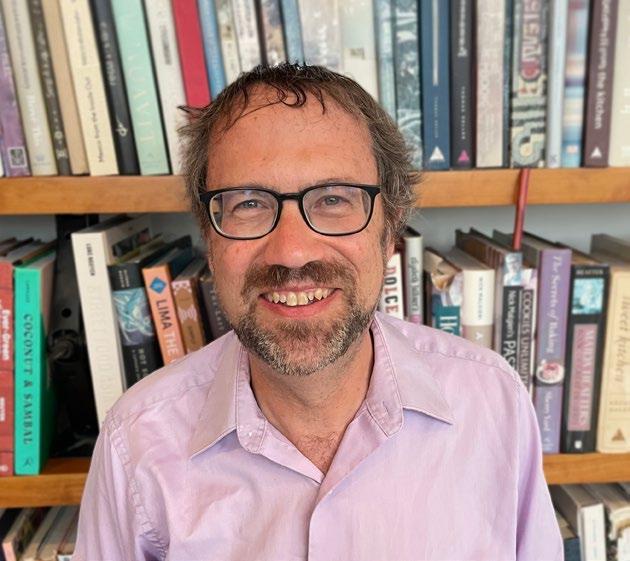
Andrew Riggsby, Lucy Shoe Meritt Professor in Classics. Photo courtesy of Riggsby.
NEW CODE FOR THE SAME OLD DREAMS
Iván Chaar López decodes border technology’s
by Lauren Macknight
past and future
Adecade ago, when Iván Chaar López first began researching drones, his Tumblr webpage served as a kind of makeshift digital archive filled with images, articles, reports, and videos he came across online. Some were cheerful depictions of drones delivering pizzas and presents, but a few more sobering pieces detailed drone strikes and deployment for surveillance in the Global War on Terrorism. The striking contrast between the two aesthetics would ultimately prove to be an impetus for his work examining the intersection of technology and border control.
“I’m less concerned about neat continuations of cause and effect over time,” he explains. “I’m more interested in moments of disturbance or emergence, moments when things congeal and come together to create a slight shift, and moments when things fall apart.”
Now an assistant professor of American studies at The University of Texas at Austin, Chaar López studies how drones and other information technologies have evolved from
tools used in aerial defense into instruments of border control. And while contemporary policy discussions around border enforcement often center on whether AI-powered systems can outperform physical walls, Chaar López poses a more fundamental question: What values and politics are embedded within these technological systems themselves? We tend to believe that a virtual border is a contemporary conception made possible by things such as drones, computers, and artificial intelligence, but in his recent book, The Cybernetic Border: Drones, Technology & Intrusion (Duke University Press, 2024), Chaar López argues that the roots of automated border control run deeper than we realize.
Growing up in Puerto Rico and in a family divided between those who advocated for statehood and those who wanted independence Chaar López experienced politics not as an abstract concept but just as life as he knew it to be. The debates that often broke out at family dinners were about politics, but they were also about competing visions of
belonging and sovereignty, and from these discussions Chaar López gained an intimate understanding of how political frameworks shape personal lives. This understanding would in turn inform his scholarly work on border technology.
Chaar López traces the first major attempt to digitize border enforcement to an experimental “electronic fence” built along the U.S.Mexico border in the 1970s. This network of ground sensors, computers, and radio transmitters emerged during a period of mounting anxiety about unauthorized migration one not so unlike our current time following changes to immigration law that led to a dramatic increase in apprehensions of “deportable aliens.”
But the electronic fence represented more than just a technical response to what was seen as a failure of the immigration system; it fundamentally transformed how the border itself was conceptualized, says Chaar López. By converting human movement into data points footsteps becoming seismic readings, body heat translated into infrared signals the system reduced complex human migration into abstract information flows to be monitored and controlled and a territory produced through the policing of its “intruders.” Notably, this technology was adapted from the “McNamara Line” used in the Vietnam War, an
artificial barrier across the demilitarized zone between North and South Vietnam consisting of listening devices and sensors alongside traditional defenses such as land mines and barbed wire. The McNamara Line example, he says, highlights how domestic border control borrowed from military operations abroad and how the U.S.-Mexico border functioned as a laboratory for the U.S. military. And despite frequent malfunctions, with sensors triggering false alarms or failing to detect actual crossings, Chaar López shows that official enthusiasm for automated enforcement remained high in government and tech circles.
These early border technologies were never neutral tools for processing migrants more efficiently. Instead, Chaar López says, they


Photo by Jonathan McIntosh via Flickr, remixed by Lauren Macknight.
were deliberately designed to transform individuals into “data bodies” that could be more easily categorized, tracked, and managed. His research also demonstrates how these systems specifically targeted Mexican migrants, embedding racial bias, he argues, into their fundamental architecture.
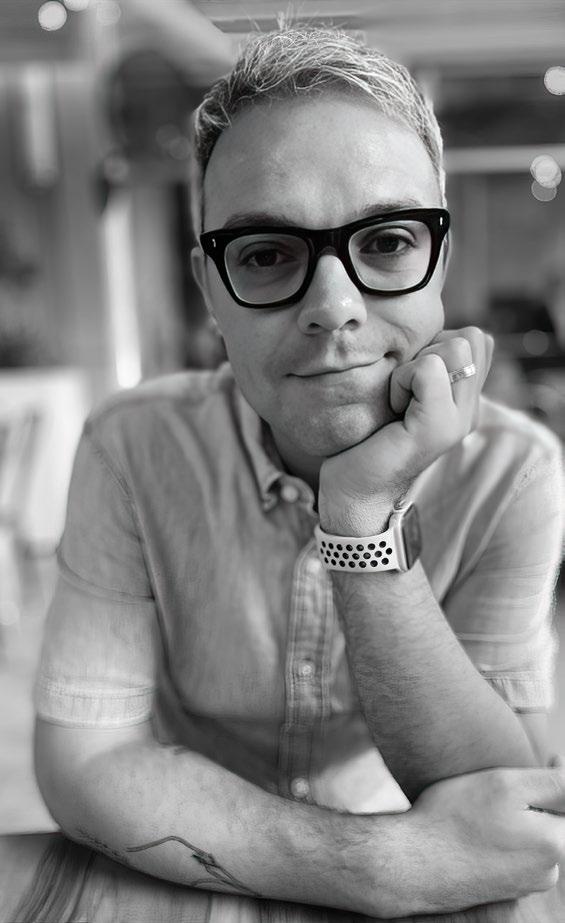
This fusion of race and technology persists, he says, in today’s border surveillance systems. Chaar López points to Anduril Industries’ current work with U.S. Customs and Border Enforcement, including their Lattice surveillance system an AI-powered sensor fusion platform as a contemporary example of how networked technologies reproduce and maintain borders. In many ways, he says, today’s AI-powered border surveillance is simply executing code written half a century ago, continuing the ideal of automated control — and its inherent biases that became embedded in America’s approach to border enforcement long before the digital age.
At UT Austin’s Border Tech Lab, which he directs, Chaar López continues to examine how these historical patterns manifest in modern border enforcement alongside broader research on computing in the Americas and digital technology and precarity. The lab investigates the technopolitics of digital systems and information infrastructures and is presently tracking the full scope of Texas’ computing infrastructure — from the mining of earth elements to the construction of semiconductors, data centers, and platforms. This work parallels Chaar López’s focus on technopolitics but employs more traditional methods of technological analysis.
Chaar López’s research methodology is deliberately unorthodox a hybrid of media archaeology and ethnic studies. He draws from an expansive list of artifacts, including promotional documents, government memoranda, surveillance footage, and protest art. The goal, he says, is to allow him to decode something essential about how border technologies function, to expose the gap between how these systems are sold to the
public and how they actually operate on the ground.
“When you hear about advances in digital technology at the border or in our daily lives it’s with a language that emphasizes the immaterial, the ethereal, the cloud,” he says. “As if it’s something that rises above, away from us. But I’m interested in grounding understandings in physical matter and material relations.”
Drawing from years of research, Chaar López argues something deeply unsettling: the future of border enforcement is less about efficacy than the illusion of it. While tech companies pitch ever more sophisticated systems of digital walls powered by machine learning and AI surveillance, Chaar López points to what he sees as the most telling part of this story how little the actual success of these systems matters to those in power. In his studies of automated and artificial barriers used in military defense to his analysis of contemporary border technology, Chaar López identifies a consistent pattern: sensors can misfire, algorithms can fail, and drones can crash, but the imperial promise of perfect technological control remains irresistible to those who wish to maintain power. “Technology, after all, includes the desires of control programmed into hardware

and human practices,” Chaar López explains. This seductive vision persists not because it works, but because it offers the illusion of clean, automated authority without the messy reality of human movement and resistance. And until we confront this fundamental political reality or imagine our way toward creative alternatives, Chaar López says, we’re just writing new code for the same old dreams of empire.

Iván Chaar López, assistant professor of American studies. Photo courtesy of Chaar López.
Image created using Adobe Photoshop AI/Adobe by Lauren Macknight.
CARMEN,Chameleon
Jennifer Wilks tracks an opera heroine’s many guises, from Bizet to Beyoncé
By Michael Agresta
Jennifer Wilks began her newest book project with a seemingly simple question: “Why are there so many adaptations of Carmen set in African diasporic contexts?”
George Bizet’s 1875 Carmen, one of the most-performed operas of all time, is based on a far lesserknown 1845 novella of the same title by Prosper Mérimée. In neither of those 19th-century texts, however, does the lead character Carmen, by now a globally recognized archetype
of an alluring and self-possessed woman living outside both the law and romantic conventions, have African ancestry. Instead, Mérimée and Bizet situate the character in Seville, Spain, among the Roma community, a group with a complex diasporic history of its own, tracing back to the Indian subcontinent.
How, then, did Carmen — a cigarette factory worker (and later outlaw smuggler) who embarks on a tragic affair with the dragoon corporal Don José,

ultimately dying at his hands when he realizes he can never permanently possess her — become a Black icon?
Wilks’ new book, Carmen in Diaspora: Adaptation, Race, and Opera’s Most Famous Character (Oxford University Press, 2024), approaches that question through a series of deep dives into performance analysis and cultural history across France, Africa, the Caribbean, and the United States. Along the way, Carmen herself comes into focus as a historical character with a life of her own, appearing again and again across epochs and continents, enticing us and challenging us to measure the great changes in our notions of freedom and female power.
“I became interested in how performers were taking on this role and applying it to different cultural contexts,” Wilks says. “Also, how this role has played an important part in the careers of so many of the women who have performed her — for good and for bad.”
The subject first occurred to Wilks, now an associate professor at UT and director of the John L. Warfield Center for African and African American Studies, when she was living and teaching in France in 2006. At a Paris independent cinema, she caught a repertory
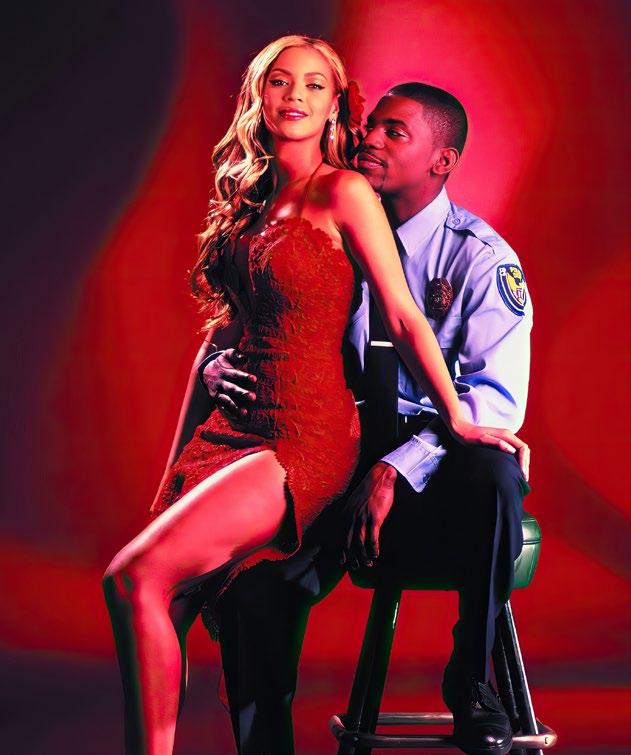
“ I became interested in how performers were taking on this role and applying it to different cultural contexts.”
Playbill of Carmen Jones . Image courtesy of Wilks.
Publicity photos of Beyoncé Knowles and Mekhi Phifer for MTV’s Carmen: A Hip Hopera , from New Line Television.
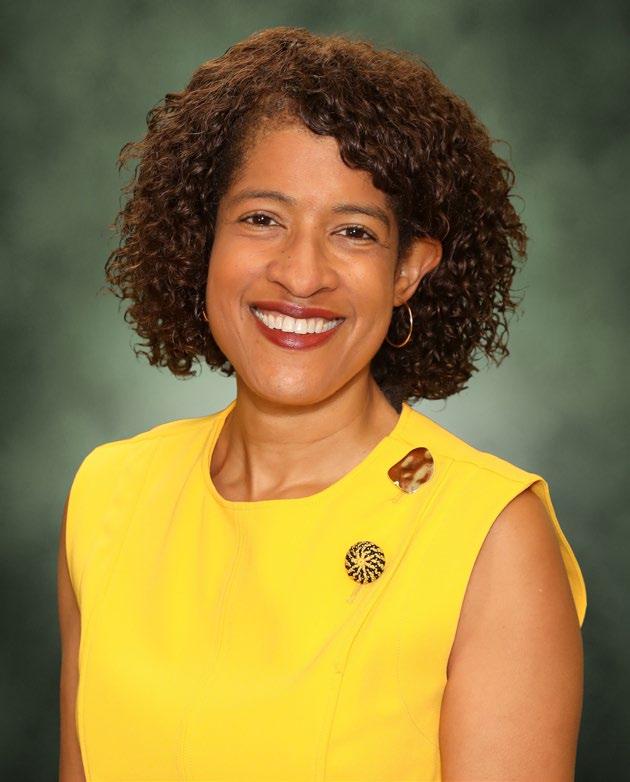
screening of the South African film U-Carmen eKhayelitsha, which had won the Golden Bear — that is, top prize — at the 2005 Berlin Film Festival. Wilks was blown away by the depth of cultural exchange and reinterpretation on display in the film.
“It was such a stunning juxtaposition of contemporary
1954 film version of the Oscar Hammerstein II stage musical, which uses some of Bizet’s music and stars Dorothy Dandridge and Harry Belafonte. Another example that came to mind was Carmen: A Hip-Hopera, a 2001 TV movie starring a young Beyoncé Knowles, which aired on MTV to much fanfare about its firstof-its-kind blending of hip-hop and operatic musical tropes. Both films are set in Black milieus in the U.S.
Wilks found a key to understanding Carmen’s resonance in America in an introduction that Hammerstein wrote to the libretto of his stage musical in 1943.
South African culture, because it’s set there in the early 2000s, and 19th-century French culture, because it is sung through to Bizet’s score,” she explains. “And it just worked brilliantly.”
After the show, Wilks thought back to other adaptations of Carmen she’d seen. These included Carmen Jones, the
“Hammerstein has this phrase, ‘The Gypsy is to Spain as the Negro is to the U.S.,’” Wilks says. “There are some problematic stereotypes that he leans into as he expounds on that idea, but what he is tapping into are very real similarities and resonances between the history of Roma populations in Europe, especially Spain, and African Americans in the U.S. and people of African descent more broadly.”
“They’re not shared histories, but they’re resonant histories,” Wilks says.
For instance, Wilks points out, Roma have had an uneven rela-
tionship to citizenship in Spain and elsewhere in Europe and have been subject to negative stereotypes. Also, Roma women are sometimes exoticized as a desired “other.” In the book, Wilks describes Carmen’s body as “one that tantalizes in its deviation from the presumably white standard and threatens because of its revelation of the fundamental instability of that standard.”
Here in America, the parallel but unequal careers of Dandridge and Beyoncé, an almost-A-lister of Golden Age Hollywood and the present-day genuine article, provide one of the most moving storylines of Wilks’ book. She includes a reproduction of Dandridge’s 1954 Life magazine cover — the first time a Black woman had ever been featured on the cover of that periodical, which was central in defining the values of postwar U.S. culture.
In this image, Dandridge stands angled away from the camera, glancing back enticingly over a bare shoulder. She wears a red flower in her black hair, a hoop earring and jangly bracelets, and places one hand on her back hip, as if mid-step in a flamenco. The cover text describes her as “fiery.” In the costume of Carmen, whose indominable charms eventually drive her jilted lover Don José to violence, Dandridge
“ It symbolizes this moment of opening, of possibility.”
enters American living rooms as both an exotic flavor and a pathbreaking studio star in the making.
“To land a Life magazine cover for any performer was a huge deal in the mid-1950s,” Wilks says. “It means you are all-American, you are at the top of your game. And then for a Black woman performer to land
a cover was even more significant. It symbolizes this moment of opening, of possibility. It means that Dorothy Dandridge as a performer has arrived, but it also points to broader strides that African American performers were making, in fits and starts, but in a significant way in the 1950s that they had not been able to make previously in the film industry.”
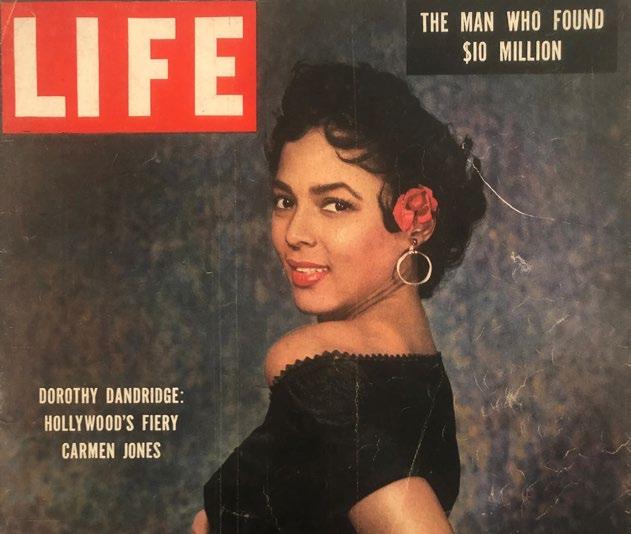
Associate professor and Warfield Center director Jennifer Wilks.
Detail from Nov. 1, 1954 cover of Life. Photo © Time Inc.
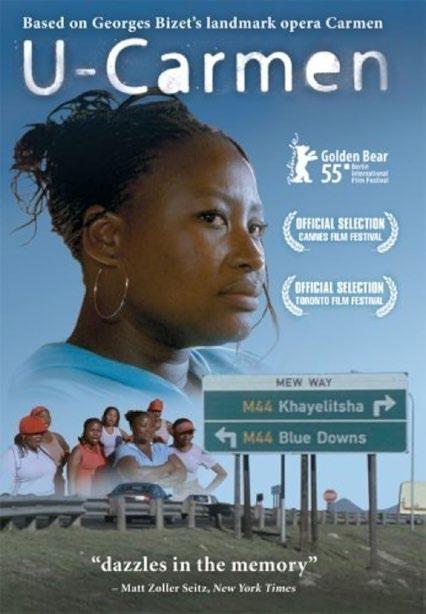
Carmen Jones earned Dandridge an Oscar nomination for Best Actress, another historic first for a Black woman. Yet for several reasons, including an explicit line in the Motion Picture Production Code (not removed until late 1956) forbidding interracial romance onscreen, her career never reached the heights envisaged by the Life cover. Dandridge died of a possible overdose 11 years later, performing in nightclubs to make ends meet.
As Wilks compares Dandridge’s career trajectory to that of Beyoncé a half-century later,
able to do after the Hip-Hopera speaks to the agency and the ingenuity that the character of Carmen exhibits,” Wilks says. “It’s interesting to think about the breadth and depth of the career that she has gone on to have, and the ways in which the early 2000s was another moment of opportunity in U.S. pop culture, but one where the window stayed open. Whereas in the ‘50s, with Dandridge, because she wasn’t able to access that agency and flexibility, that window closed for her quickly after Carmen Jones.”
“ Carmen has become an eternal, almost infinitely adaptable figure since the 19th century.”
directed by men, do lean into those complications in many ways, but I would be curious to see how more women interpret this work.”
Wilks describes Carmen as, at its core, the story of a woman with boundaries, one who sings in her first and most famous “Habanera” aria, “If you love me, beware!”
a major shift is evident. The mononymous mega-star was beloved by fans of her girl group Destiny’s Child in 2001, but she was not a big enough name to even earn Carmen:
A Hip-Hopera a theatrical release. Today, Beyoncé might be bigger than Carmen herself in terms of global recognition and legacy. Wilks attributes her success to both good historical timing and an ability to dictate the rules of her game in a way that Dandridge could not.
“I wouldn’t say that Beyoncé created a Carmen playbook for her career, but what she was
Much of the heft of Carmen in Diaspora is devoted to lesserknown adaptations of the source story. Wilks came to the topic as a scholar of Black modernism in the U.S. and Caribbean, and she begins her investigation with an analysis of “echoes of Carmen” in the novels of Wallace Thurman and Claude McKay, two writers associated with the Harlem Renaissance. This section underscores from the start the fact that it was Black creatives as much as those of European descent, like Hammerstein, who built the connection between Carmen and the African diaspora. Wilks also devotes serious attention to Carmen la Cubana, a 2016 musical which readapts Carmen Jones’ story back to the stage and connects her to the story of the Cuban Revolution.
Wilks says the most fortuitous moment of her research was discovering Karmen Geï, a Senegalese film that first premiered at Cannes Film Festival in 2001. This adaptation finds a way to make the Carmen story sing in a fully Senegalese setting, using none of Bizet’s music; instead, the filmmakers employ a mix of traditional Senegalese music and American jazz. Wilks describes it as a sophisticated work that is the product of a post-colonial culture steeped in the French classics yet confidently speaking to a homegrown as well as international audience.
“It’s a testament to how people in Francophone societies that were colonies of France know French culture, but their work can be wholly Senegalese,” she says. “It is not a subordinate relationship to French culture. It is a peer relationship, and Senegalese culture is just as prominent. The richness of
Senegalese culture is absolutely center-stage in that work. It’s probably my favorite adaptation.”
While Wilks sees many reasons to celebrate the role of Black creatives in claiming and transforming the legacy of Carmen, she does note with some disappointment a lack of female creative voices in the examples she’s found to write about. While the South African film U-Carmen eKhayelitsha credits female co-writers, most of the authors and directors she writes about are men.
“That’s important, because for so long Carmen has been known as this femme fatale,” Wilks says. “She’s the woman who lures men, in particular Don José, to their ruin, and she’s been reduced to that. That certainly brings dramatic tension to the work, but it’s a much more complicated story. The adaptations that I write about in the book, those
Fortunately, woman-directed productions of Bizet’s Carmen — like the one at Austin Opera in May 2024, or the Metropolitan Opera’s New Year Eve 2023 production — are becoming more common, Wilks says. What remains is to see more women, particularly in the African diaspora, carry on the rich tradition of adaptation.
“Carmen has become an eternal, almost infinitely adaptable figure since the 19th century,” Wilks writes in her book’s introduction. We can only expect that entrusting Carmen’s story to new generations of female storytellers and directors will reveal further, unexplored aspects of what Wilks calls her “unruly, powerful womanhood” to the world.
Michael Agresta has written for Texas Monthly, The Atlantic and The Wall Street Journal.
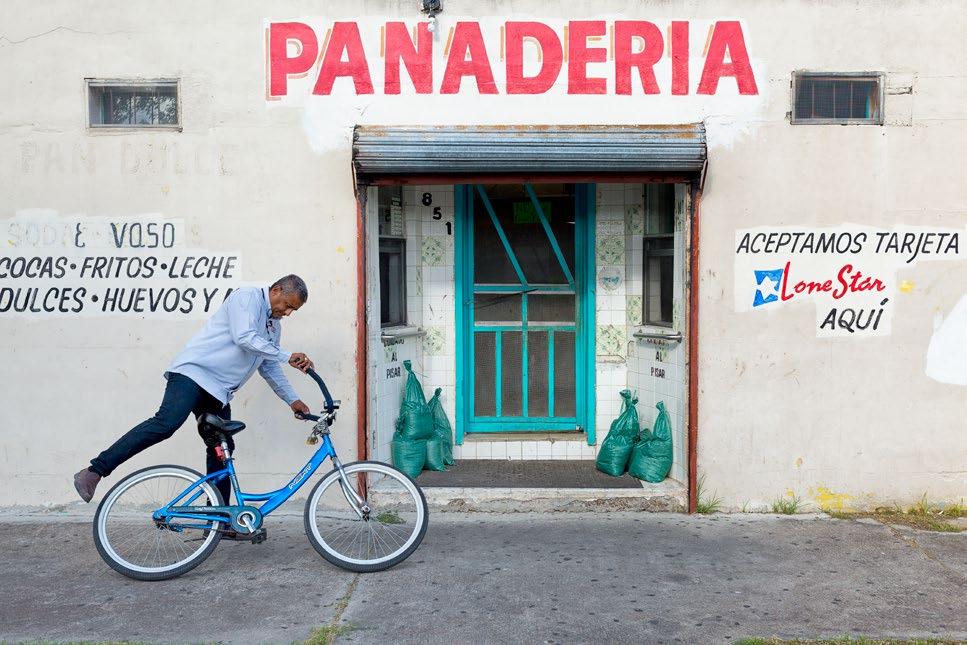
FROM THE BORDER WITH LOVE
Oscar Cásares wants to show you where he’s from
BY KAULIE WATSON
The lights dim; the theater goes quiet. On stage, a screen lights up with a video shot of someone’s desk, and the sound of a phone ringing echoes through the room. The call goes to voicemail, and someone leaves a message: “Hi Carrie! It’s me, Oscar. Listen, I have an idea for a show! It’s about the border…”
What follows is part performance, part multimedia experience. There’s video, live music led by singer-songwriter Carrie Rodriguez, and gorgeous photography from across the Texas-Mexico border. And, perhaps most importantly, sitting at a desk to stage left, there’s Oscar Cásares as himself: a man obsessed.
A few years before Cásares, a professor of English and director of the New Writer’s Project at The University of Texas at Austin, made that opening phone call — or, rather, one very like it — he’d published an article in Texas Monthly titled “The Other Side of the Border.” The piece follows a road trip Cásares and his friend and collaborator, the photographer Joel Salcido, made along the length of the Texas-Mexico border shortly after the release of Cásares’ second novel, Where We Come From. As the pair traveled, both sought to record evidence of the border region where they grew up — one markedly different, more joyful, richer, and more complex, than the relentlessly negative version they saw in the news. Salcido photographed locals as they played in the Rio Grande, walked the streets of El Paso’s El Segundo Barrio, or harvested grapefruits near Mission, Texas. And, in a series of postcards addressed to his daughter Elena, Cásares told their stories.
“The idea behind that essay came from my daughter calling me out and saying I was obsessed with the border,” says Cásares, who grew up in Brownsville and still has strong family connections to the region. “I couldn’t quite deny it, so I had to ask myself why I was so obsessed and why I felt so compelled to counter the narrative the media was making out to be the border.”
“I had to ask myself why I was so obsessed and why I felt so compelled to counter the narrative the media was making out to be the border.”
Cásares’ passion for the region is evident in his writing in the original essay, which is rich in moving detail even as it’s condensed down to its sparest form. He carefully describes a family playing in the river under the watchful eyes of border guards, oblivious to their observers, “like they’d forgotten there was a this side and a that
side.” We read of a young music teacher walking her daily commute across the bridge from Ojinaga to Presidio, carrying her mariachi outfit for a performance with her students. At the essay’s end, two fishermen wave smilingly across the water at Boca Chica, where the Rio Grande meets the Gulf.
“Writing these was an interesting exercise, because I understood that they had to communicate quite a bit in a very short amount of time,” Cásares says. “I studied a lot of narrative poems to try to compress my language down to its bare essence. And we’ve continued to shorten the original ones for the show, because there are more postcards in the show.”
For years the essay version of “Postcards” was the only one; a theatrical adaptation wasn’t in Cásares’ or Salcido’s minds when they filed the original story. After all, few magazine articles make the jump to the stage. But the idea of adapting the piece for performance emerged organically from the pair’s web of connections and interests, then bloomed into something like its current form in the dark days of the pandemic. Several years later the show version of “Postcards From the Border” was ready for audiences — it debuted in UT Austin’s McCullough Theatre in January — and it really did start with a cold call.
“I called Carrie out of the blue. I mean, she barely knew me,” Cásares says. “But surprisingly she heard me out, and then I sent her the essay with the cards and she was like, ‘I’m really into this. I like it, let’s see where this goes.’”
In some ways the project was a natural fit: Rodriguez, an Austin-based, award-winning singer-songwriter and performer, is no stranger to the border, or to UT. As the university’s current songwriter in residence, she leads workshops, discussion panels, and concerts for the UT Austin community, and her signature project is the
Mr. Ben’s Bakery at corner of E. Madison and E. 9th streets in Brownsville. Photo by Joel Salcido.
“Postcards” show, for which she composed four new songs. But when she, Cásares, and Salcido first discussed the possibility of working together, they had no way of knowing where the postcards would lead.
After some early experiments performing the cards alongside music by Rodriguez as part of her Laboratorio concert series at downtown Austin’s State Theatre, the three collaborators decided to seek outside funding to expand the project. That support soon came through in the form of a grant from the New England Foundation for the Arts’ National Theater Project, made possible by the Mellon Foundation, and it enabled Cásares and Salcido to take Rodriguez and a film crew on a second tour of the border.
That trip resulted in the video footage included in the final stage show, which includes clips of Cásares and Salcido driving down miles of border highway, swapping stories both old and new. It also features interviews with Cásares’ family, filmed during a family reunion in Pharr, Texas, organized by his cousin Eddie, that he hopes will shed light on the unique beauty of day-to-day life along the border.
“Those interviews were quite moving, and there was a lot of family history and things that, because of my age and the fact that some of my cousins are much older than I am, I just had not experienced. Stories about my own family, my own siblings, that I didn’t know,” Cásares says. “And what is connecting with our audiences is those themes of family and that humanness.”
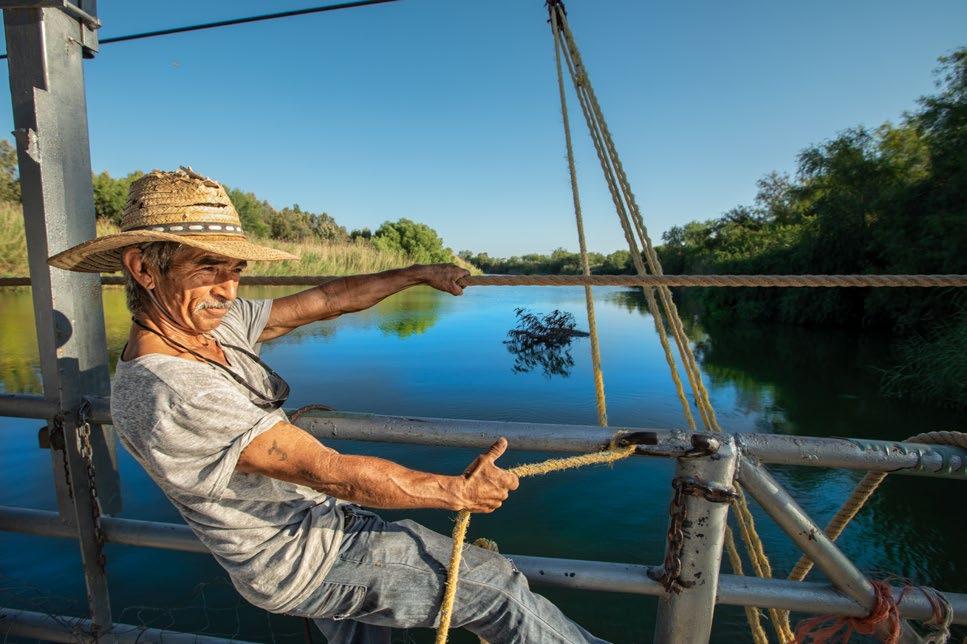
The humanity the show aims to display is at the core of Cásares’ border “obsession,” and his hope for the production is that his passion will be catching. At each step of the development process behind the “Postcards” show — which involved Cásares, Salcido, Rodriguez, and her bandmates gathering for a series of residencies to hash out the details of their performance — Cásares emphasized the importance of showing audiences the full experience of living along the border.
“Part of what I was telling the team when we got together is that, whatever this ends up looking like, I wanted to recreate the experience of what it is to take someone to the border. I wanted the 75 minutes to be this kind of feverish dream where you are on the border and you’re hearing the border, you’re seeing it, you’re experiencing it in this utterly immersive way where your sense of direction and perspective is altered,” he says.
Sitting in the theater before the lights come back up — as Cásares reads his last postcard about swimming between the U.S. and Mexico “under a sky that belongs to all of us” and Rodriguez and her band play through the show’s final song, the appropriately titled “Cumbia Frontera” — the show does feel like a kind of dream. In an hour the audience has travelled some 1,250 miles from El Paso to the Gulf and met an incredible array of people who live their lives, full of difficulty and beauty and family and loss, the same as any life, where two countries meet. And Cásares and his collaborators want as many audience members as possible to encounter the show — and, through it, the region that they care about so much.

“I wanted to recreate the experience of what it is to take someone to the border.”
“We want to take the show to the border,” Cásares says, “so we’re talking to people in Brownsville,
we’re talking to people in El Paso and in New Mexico, but we’re also talking to people in California and New York.” The grant that made the “Postcards” adaptation possible also facilitates taking the final show to communities that may not have the resources to pay for the entire program, he adds, which should help expand the project’s reach.
Wherever the show goes, Cásares wants the audience to have the same experience.
“It’s like, ‘Hop in the back seat, we’re going down to the border,’” he says. “Let me actually show you what my home is like.”
Jose Angel “El Greñas” Gonzalez manually pulls the international ferry across the Rio Grande between Los Ebanos and Gustavo Diaz Ordaz. Photo by Joel Salcido.
Grapefruits at the Rio Grande Juice Company in Mission, TX. Photo by Joel Salcido.
THE ANVIL OF READING
On an old-school aid to thinking clearly
BY MICHAEL ERARD
When I was in the English Ph.D. program at UT Austin in the 1990s, a friend, Dana Maya, shared with me a framework for dissecting complex works of literary theory that she’d learned in a class with Katherine Arens, a literature scholar and professor in the university’s Department of Germanic Studies. This framework, as I recall, was a formidable tool, because with it you could crunch the densest scholarly text into a single page of its distilled essence, and then pin it, like a captured butterfly, into a binder, and in that way trace your intellectual journeys.
Recently, this tool came to mind again as I wanted to equip my teenager with an intellectual practice he could grow into. But I realized that my long-ago encounter had been too glancing — I couldn’t even recall the tool’s name.
Arens kindly replied to my email. “You must be referring to the précis,” she wrote, attaching the handout she’s
used for three decades. “There is a difference between a text’s facts and the strategy used to present those facts,” it begins, “and the précis (‘pray-see’) reflects this difference.”
And so began a renewed relationship with this unique pedagogical artifact.
At first glance, the précis appears disarmingly simple. Using the scaffold of “focus,” “logic,” “goal”; a matrix of examples; and “implications” you are to identify and evaluate what an author argues — not what the article is about, not how you feel about it. Making a solid précis takes 15 minutes. Spend no more than 45, Arens counsels. It’s only one typed-page long, after all.
But then, things get complicated. Making a précis means locating the logic of the work (and the work can be a book, a movie, even a building), representing that logic by assembling facts drawn from it, then evaluating it. A rubric, of sorts, that demands that you fill every cell.
It’s much more than an aide memoire, in other words. It’s a powerful thinking and teaching tool with many facets: how it demands that you represent what’s present in the text, in terms of what that text set out to do; how it becomes a filter for everything someone sees or reads or hears, a habit of mind, once they’re inculcated with it; how assigning it to students remediates some of the excesses of modern educational practice, such as a preference for reaction papers.
“THERE IS A DIFFERENCE BETWEEN A TEXT’S FACTS AND THE STRATEGY USED TO PRESENT THOSE FACTS AND THE PRÉCIS (‘PRAY-SEE’) REFLECTS THIS DIFFERENCE.”
All this I learned from talking to a few of the university teachers who, having learned the précis from Arens, now constitute a sort of fan club of soft evangelizers — “apostles,” jokes Arens. Given the chance, members of her précis crew will rhapsodize about how they use it in their teaching and writing: how it can be scaled up (about a book) or down (about a chapter, a page, a paragraph); how it puts participants in a class on the same level; how it can be objectively assessed; how it neutralizes conflicts over political differences.
Indeed, my old classmate Dana Maya recalled how, in the highly charged environment of literary studies in the 1990s, making and reading précis reduced the temperature of clashes between people with opposing theoretical commitments, all fighting with their moral reputations at stake. “In Arens’ class we weren’t trying to prove that we’re good people,” she says, “we were trying to understand what the purposes of this writer in this context were.” The clarity of the intellectual work, stripped of its politics, was soothing, oddly so for its rigors.
The roots of the précis date to the 1970s. Janet Swaffar, now a professor emeritus of Germanic studies, developed a method of reading in a
second language, drawing from the cognitive psychology of learning, particularly the order in which certain things are more easily learned. All this was described by Arens and her coauthor in their 1991 book, Reading for Meaning: An Integrated Approach to Language Learning.
The idea is that people manage complexity, particularly in a new domain, by looking for patterns, recognizing recurring patterns and how they’re linked, then identifying the substance underlying them. Such a process gives intermediate learners of a second language access to sophisticated texts that they are well-prepared to understand because they have adult minds, even if their linguistic skills for articulating their insights are less mature. Making a précis teaches them to reproduce not only the language but the broader linguistic and cultural conventions in a text.
It turns out this scaffolding is also well-suited for learning the peculiar linguistic registers of academic disciplines, which is how Arens and others came to apply the précis beyond learning German or Spanish. The idea is that eventually a newcomer to sociology or management theory could come to sound like people in those fields and, more importantly, discover how to fluently participate in disciplinary conversations.
“Too many times, courses for majors say how you’re supposed to do things, which really only matters if you’re in a chemistry lab and want people to follow bedrock rules so you don’t blow things up,” Arens said. “Otherwise, there’s a whole space of figuring out ‘What sort of experiment do I do on a new case?’ Oftentimes students don’t necessarily know what is required to be an active participant in a particular context. We know they can write a paragraph — but can they write the paragraph they need for a specific purpose?”
For all its intriguing strengths, the précis can be difficult to describe, which is why it attracts a lot of metaphors.
“It’s like a screwdriver,” offers Carlos Amador, a Latin American studies professor at the University of Buffalo, “in the sense that it’s a simple tool that enables you to see a seemingly complex object as an assemblage of simpler components.” Says Amanda Randall, who teaches German at St. Olaf College, “I still tell students what Katie told me the précis is good for: cracking open a text to see how it works.” However, it’s not just a tool for critical thinking, Randall says. “It’s a site for mapping the kinds of sorting work that critical thinking actually consists of.”
A précis created for a class taught by a former graduate student of Arens. The text is Heinrich Böll’s short story “Wanderer, kommst du nach Spa…” (Stranger, Bear Word to the Spartans We…). Courtesy Amanda Randall.
However, not all students come to the précis smoothly.
“I remember people hating it,” Maya said. “It was not easy at all.” Amador, who didn’t get it at first, disliked it too. Another former student of Arens’, Jason Roberts, now an assistant professor in UT
Précis Worksheet
TITLE: Sarah R., 19 October 2024. Böll, Heinrich, “Wanderer kommst du nach Spa…”. 1950.1
I. FOCUS: Images of empires in Heinrich Böll’s short story
II. LOGIC & GOAL: When one examines the images of empires in this post-World War II literary work, one sees how the imperialist ideology of National Socialism was fixated on a romanticized past.
II.1 Table:
In the Short Story In German History
Böll’s narrator describes several symbols of ancient Greece and Rome as he passes them in the school, such as the frieze of Zeus and the Parthenon, as well as a recurring description of the busts of Caesar, Marcus Aurelius and Cicero. (p. 47, 47)
Böll’s narrator notices an image of “Old Fritz.” It is described in a complimentary light–as beautiful, large, and colorful. “Old Fritz” is also painted as powerful and heroic in his military uniform. (p. 46)
The narrator notices a painting depicting Togo. The painting’s focus is on plentiful bananas, with the African people obscured in the background. (p. 47)
III. IMPLICATIONS
Caesar Marcus Aurelius and Cicero were important figures in the Roman Empire, and the god Zeus and the Parthenon temple in Athens are emblems of ancient Greek civilization. The National Socialists admired the strength of these ancient empires, and frequently adapted their aesthetics for creating imagery for the Third Reich.
Friedrich the Great (a.k.a. “Old Fritz”, 1712-1786) was a king of Prussia remembered for his many military victories and expansion of Prussia’s territories, in particular the defeat and annexation of Silesia (in modern Poland), a region that Germany lost in WWI, retook in WWII, and lost again thereafter.
Germany had colonies and protectorates (Schutzgebiete) in Africa, including Togo, but lost them all as a condition of the Treaty of Versailles following its defeat in World War I.
In “Wanderer, kommst du nach Spa…”, the halls of the school-turned-field hospital through which the narrator a wounded young soldier, is being carried are lined with images of ancient and modern empires, pointing to the National Socialist imperialist drive. The Nazis yearned for an idealized image of Germany’s military and economic glory days, before its defeat in World War I, and imagined a new regime that would match the ancient glory of Rome and Greece. German schools were filled with such romanticized imperialist imagery, and Böll’s description of what the soldier sees in the hallways of his former school reminds readers of how the society became indoctrinated. The soldier comments positively if wistfully on the images as he passes. Yet, the readers know, those images are of fallen empires, existing only in the past, never to be emulated or resurrected. The noble Roman busts and the painting of Togo, in which bountiful natural resources obscure the racialized people, capture both Nazi Germany’s imperial aspirations and the regime’s concomitant racial supremacism. Through these images of fallen empires, Böll reminds readers in 1950s Germany–less than a decade after the fall of the Third Reich–of the ubiquity of the regime’s imperialist aims, and the ultimate senselessness of those mythologizations.
Publ shed in Bö l He nr ch 1967 Wanderer, komms du nach Spa Erzählungen München Deutscher Taschenbuch Ver ag
Austin’s Department of Slavic and Eurasian Studies, came to graduate school with what he described as a fast but messy mind. “I experienced the précis as a student who needed a kind of rehabilitative therapy for how to think logically,” he remembered. He shared with
In Arens’ experience, students are either converts to the précis or they ignore it. It works best for those who have struggled in classes that ask for analytic writing, “because it’s probably the first time that anyone told them there’s a logic to all of this.” It also works very well for young adults who have always been considered the smartest person in the room. Précis-led thinking slows them down and shows them how to structure their own contributions, “so they can be the most effective smartest person in the room,” she says.
For instance, look at the matrix, which organizes quotes and other items pulled from the text. The rows across constitute a proposition — that some cause A will have an effect B, for example — while the columns gather types of causes and effects in the text. From the matrix, you can derive the logic of the argument at a higher level of abstraction; if it wobbles or gets vague, you know the argument is not wellconstructed.
could tell that the two précis are about the same novel.
Despite its virtues, the précis gets infrequent traction outside the Swaffar-Arens lineage, perhaps because you really have to see its alchemy in action. Plus, it’s not a genre of text you bump into out in the world. Yet it proves sticky for those who get it. Arens now has students who learned the précis from their high school German teachers, who got it from her.
Yet there’s a twist in the story of the précis: it wasn’t the only product of the procedural learning science of the 1970s. That work was also applied to helping computers to learn efficiently, leading eventually to an approach called expert systems, which spawned what we know as generative AI. Yes, that’s right: the précis and systems like ChatGPT are siblings.
fills the patterns with erroneous particulars, not because it’s stupid or malicious but because that’s just what it does.
So, count me as the newest member of the précis crew. The message for humans (as I’m going to tell my teenager) is that we have to keep trying to become connossieurs of abstraction, to focus on becoming the most effective smart person in the room. One very good path is clearly the précis. Learn it sooner rather than later, I’ll tell him, because it’s a tool you will someday regret not having. I know, because I do.
Michael Erard is the author of Bye Bye I Love You: The Story of Our First and Last Words (MIT Press, 2025), among other books. He received his MA in linguistics and a Ph.D. in English from UT Austin.
me a testimonial from a former student: “By first searching for the argumentative structure and distilling it into its key points I could give myself a roadmap for then reading an article line by line.”
Also, because the matrix can be filled in many ways, no two people will produce the exact same précis. If they were doing a précis about a novel, for example, one person might focus on cause-and-effect relationships having to do with scenes of escape, another on matters of identity. And yet you
The contrast is striking, because generative AI often seems poised to take away from humans the cognitive flexibilities that a good précis demands. Yet learning the backstory of the précis has illuminated for me how generative AI works — and why it fails. The précis teaches you to identify frames or patterns of arguments, shows how some patterns depend on each other, and suggests how those patterns are built up from particulars. Generative AI is good at this too, except that sometimes it
“WE HAVE TO KEEP TRYING TO BECOME CONNOSSIEURS OF ABSTRACTION, TO FOCUS ON BECOMING THE MOST EFFECTIVE SMART PERSON IN THE ROOM.”
A CITIZEN Y ARTS
JAMES COX GIVES CHEROKEE
PLAYWRIGHT LYNN RIGGS HIS DUE
By Leora Visotzky
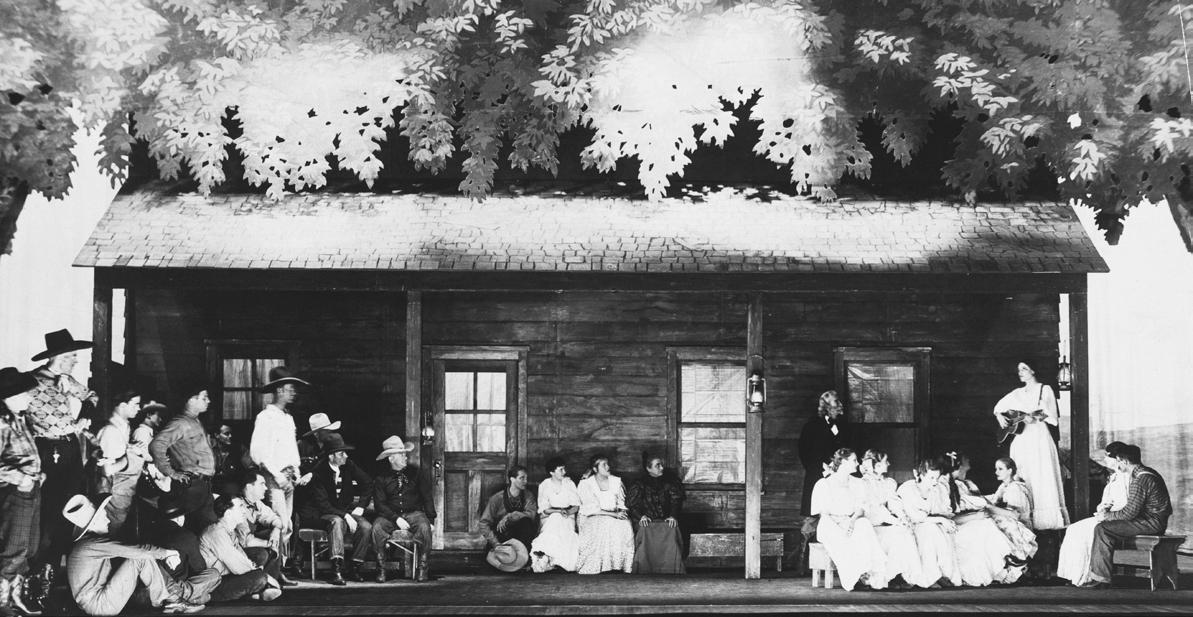
It’s a good moment for Native American and Indigenous literature, says English professor James Cox. Native writing has exploded in genre fiction — like mystery, science fiction, and horror — and while it’s fair to say that Native American literature is still a small field, work by Native scholars and writers has had an outsized impact in the U.S. in the last 10 years when it comes to winning major literary awards and cultural recognition.
Cox would know. The co-founder of the college’s Native American and Indigenous Studies (NAIS) Program, he’s written or edited four books on 20th- and 21st-century Native American literature and the history of Native Americans in American literature and culture.
He credits some of the increased visibility of his discipline to the recent proliferation of Native stories in popular culture: shows like Reservation Dogs on FX, whose creator Sterlin Harjo just won a MacArthur; Disney’s miniseries about Marvel’s Echo character, played by Menominee actress Alaqua Cox (no relation); or the movie Prey, dubbed in Comanche, from the Predator series. But these examples are just the latest in a long line of Native creative work that has gained broader recognition over the past century, Cox says, and there are many writers and artists who built the foundation that led to this moment.
A cornerstone of that foundation, he says, is often traced back to the Native American Renaissance, a prolific period of Native American cultural and artistic production, spurred when Kiowa author N. Scott Momaday won the Pulitzer Prize in fiction in 1969 for his novel House Made of Dawn. The period that
followed this book, Cox says, brought more Native writers to a broader reading audience and, along with the American Indian civil rights movement, opened a window for Native American visibility in politics, the arts, and more.
But Cox’s own scholarship reaches back further, to Rollie Lynn Riggs, a Cherokee playwright, author, and renaissance man who was active in the 1920s and ’30s, decades before the Native American Renaissance would formally begin.
You probably don’t know that you already know Lynn Riggs. His 1931 Broadway play, Green Grow the Lilacs, was later adapted by Rodgers and Hammerstein into the smash-hit musical Oklahoma! — and that’s just one of the more than 20 plays he wrote, in addition to dozens of films, TV scripts, and poems.
Riggs was a prolific writer whose work spanned drama, poetry, and more, and in many of his works he focused on Indigeneity and the experience of being a Native person in the Americas. He brought these themes to the public through his plays in particular, which Cox and co-editor Alexander Pettit collected in a new book from Broadview Press, Lynn Riggs: The Indigenous Plays (2024).
The conventional wisdom has been that Native writing before the Renaissance was too politically passive, Cox explains. At least one of Riggs’ plays, however, undermines that view. “One of his plays set in Mexico, The Year of Pilar, is, politically speaking, the most extraordinary piece of writing before the Native American Renaissance,” Cox says. The play is not only supportive of Native culture and communities, it’s also explicitly anti-colonial, which was highly unusual for its time.
Left: Theater still from Green Grow the Lilacs 1930–Photo by Vandamm Studio, The New York Public Library for the Performing Arts.
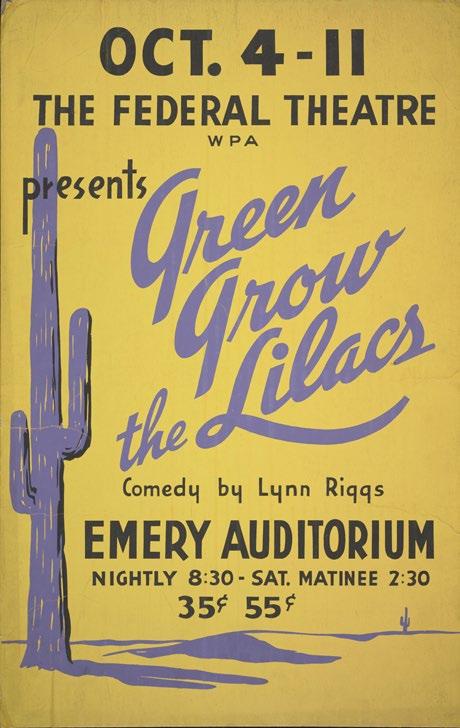
“It’s a play that resonates still in 2024. People we introduce it to can’t believe it’s from the ‘30s,” Cox says.
Despite its significance, Riggs wasn’t famous for The Year of Pilar, or particularly famous in general despite his popularity. It’s not that he was unknown — he won a Guggenheim and had plays on Broadway and scripts in Hollywood — but there were bigger-name playwrights at the time, like Eugene O’Neill, Tennessee Williams, and Thornton Wilder,
who held the spotlight. Riggs, by comparison, remained somewhat under the radar in terms of name recognition. And because Riggs produced so much, his work was sometimes perceived as unpredictable, full of shifts and experimentation, which left some audience members who expected one thing disappointed when they got another. As a consequence, he isn’t easy to teach in a survey course, especially one filled with other writers from his period, and so Riggs’ writing has gone undertaught and underappreciated.
But leaving Riggs out of the history of Native literature and U.S. drama is a mistake, Cox says. Because he was both so rooted in his Native American family and community and traveled and presented his work to such a broad audience, from local community theaters to Broadway, Riggs shared a genuine and rare window onto Native American life during his time. He presented the public with scenes that explored racial and class divides and the impact of federal legislation on Native American and Indigenous communities, and that dispelled stereotypes of Native Americans to broad, non-Native audiences.
By setting many of his plays in regional Indian Territory and writing in northeast Oklahoma dialect, for example, Riggs demonstrated that Native cultures of Northeastern Oklahoma, the Southwest, and Mexico were integral to the history of the U.S. in a way that other writers and dramatists weren’t yet doing — and he wove those threads into the canon of entertainment at the time across the United States.
“He had a real commitment to his regions’ [northeast Oklahoma] voices, and he felt strongly about that,” says Cox.
“IT’S A PLAY THAT RESONATES STILL IN 2024. PEOPLE WE INTRODUCE IT TO CAN’T BELIEVE IT’S FROM THE ‘30S.”
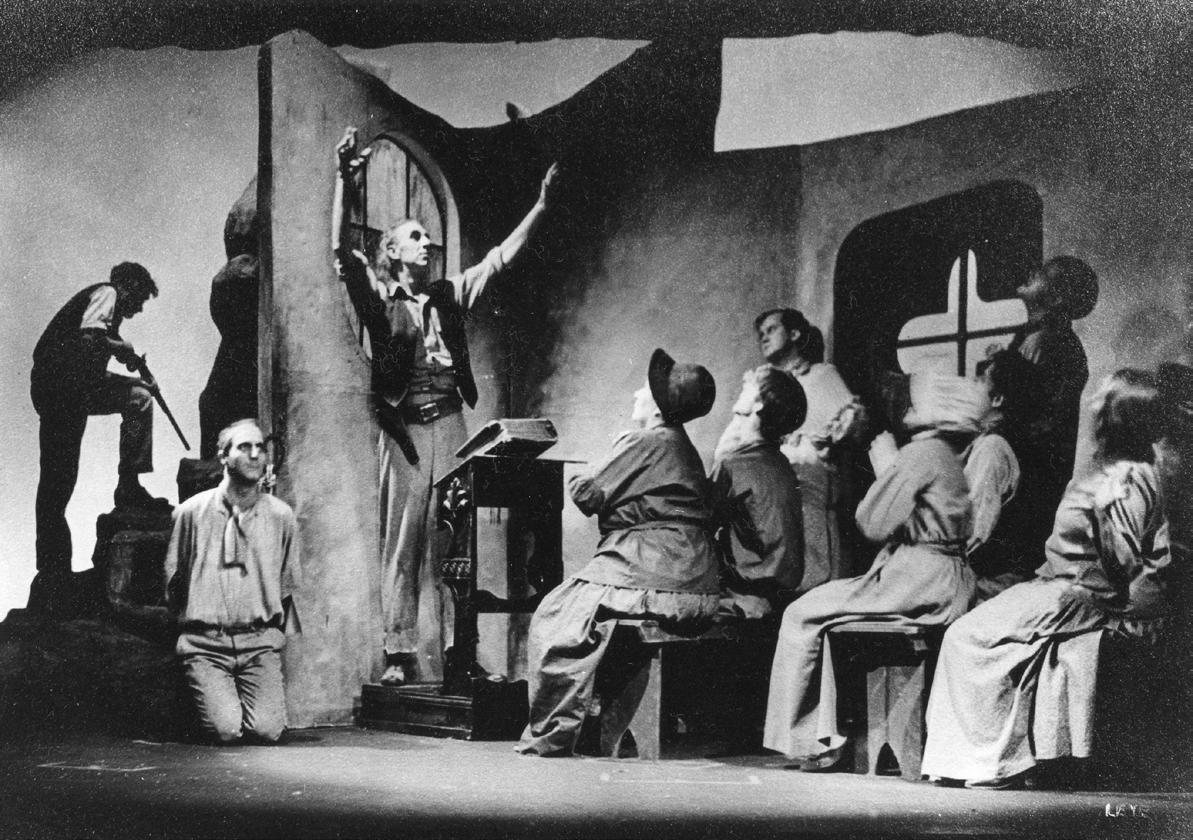
Green Grow the Lilacs poster. From Federal Theatre Project Collection (Production Records, 1934-1943:Posters File), Library of Congress, Music Division.
A scene from The Cherokee Night by Lynn Riggs as presented at the Provincetown Playhouse by the Community Theatre Division of the Federal Theatre Project, July 1936.
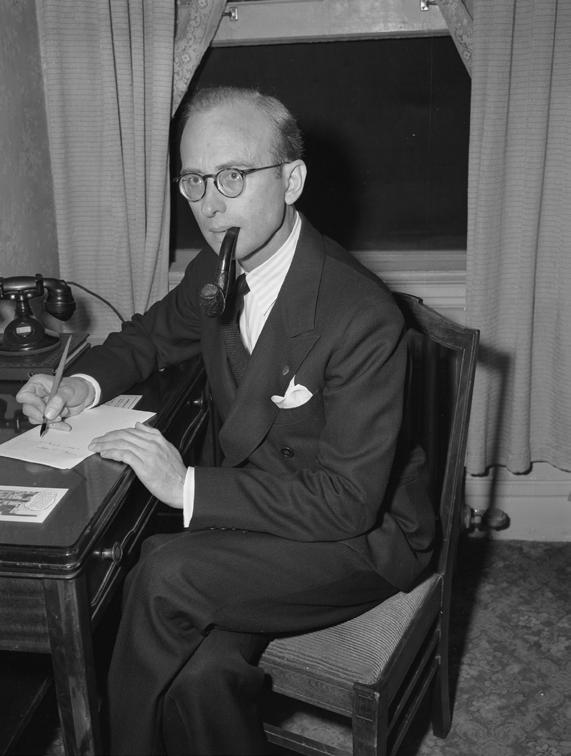
Riggs’ experimental play The Cherokee Night, which premiered in 1932, features a young generation of Cherokees both before and after the establishment of Oklahoma statehood in 1907, an event that disintegrated tribal governments in Indian Territory and claimed lands that Indigenous communities didn’t gain back until the 1970s. The play begins with a group of young people of both Cherokee and white descent at a picnic, and slowly descends into betrayal and murder in a community impoverished by centuries of cultural oppression.
“That was a pretty bleak era in a long series of bleak eras, particularly for the Cherokees,” says Cox. “The play is grim and violent, but it’s
“THE PLAY IS GRIM AND VIOLENT, BUT IT’S A FAVORITE OF N.A.I.S. LITERARY SCHOLARS BECAUSE IT’S SO FORMALLY AND POLITICALLY EXTRAORDINARY AND A CREATIVE DOCUMENT ABOUT CHEROKEE LIFE FROM THE 1890S-1920S.”
a favorite of NAIS literary scholars because it’s so formally and politically extraordinary and a creative document about Cherokee life from the 1890s-1920s.”
Riggs’ 1936 play Russet Mantle, on the other hand, had a lighter tone. It satirized the affluent Anglo classes in Santa Fe and helped establish Riggs’ reputation as both a comic voice and an adept writer of dialogue. It proved his most popular production, premiering on Broadway and running for 117 performances.
This chronicling of local Native life, landscapes, and historical milestones is a feature of Riggs’ work that has also become a hallmark of Native writing in general, Cox says. And Riggs’ use
of themes and historical references common to Native writing — such as the impact of federal legislation, the diminishment of tribal sovereignty, and the use of multiple voices and perspectives — helped to normalize their presence for broad audiences. This ensured that writers who came after him were able to connect with popular audiences and receive their due.
The theme of multiple narrators is a particularly important one, Cox says, as it emphasized the nature of Native communities as collective and collaborative. And while these were simultaneous voices in discrete pieces of writing, we might also look at the canon of Native literature as serving this purpose more broadly, with multiple narrators telling the story of Native people.
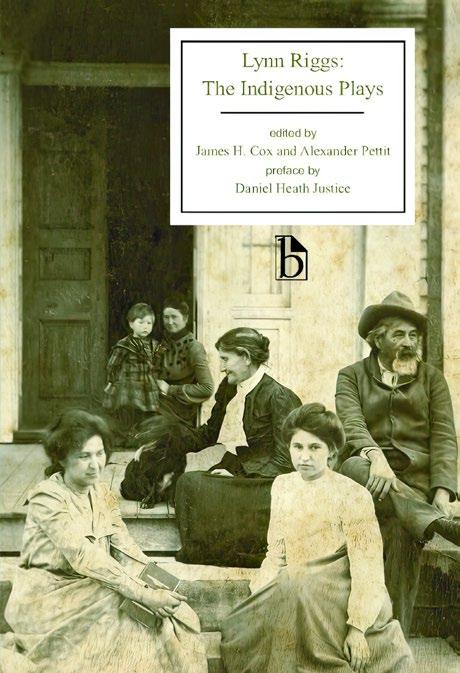
True to the importance of the collective voice, Cox explains, Riggs himself embodied this idea both within the content of his work and in his methods of working. He lived for collaboration and couldn’t have done his work at the level he did without it. Cox began to flesh out just how central the role of collaboration was for Riggs in a presentation for a conference for the 100th anniversary of the Native American Citizenship Act of 1924, which granted citizenship to all Native people. Cox revised this work for an article forthcoming in American Literary History
“We were asked for the conference to think about citizenship, and I thought about the way Riggs lived his life and was an intensely loyal friend, and many of his friendships involved collaboration: José Limón, George Gershwin, Aaron Copland. People reached out to him to collaborate. So, I proposed that Riggs worked as ‘a citizen of the arts’ by supporting younger artists and friends and promoting them. It was a rare day he wasn’t reading his friends’ poems or songs. It’s why I think he’s such a fascinating figure. He knew what he loved and was devoted to it and wanted others to be devoted to it as well. Part of my argument as to why he chose theater/drama is because it’s inherently a collaborative art. He really preferred to work with people.”
As for the momentum of the current moment for Native literature, Cox hopes that it continues to bring more attention to Native people more generally. “It feels really good to have Native writers win awards and to have my colleagues outside of Native studies ask me about these books,” he says. “It’s all connected. The more writers you have, both creative and scholarly, spreading their ideas and talking with people, the more attention is on the many issues that Native people face.”
Lynn Riggs, University of Texas at Arlington Libraries, Special Collections, Fort Worth Star-Telegram Collection, AR406-6-1433
WANT TO JOIN THE LITERARY MOMENT BUT NOT SURE WHERE TO START? HERE ARE COX’S RECOMMENDATIONS:
If you think of yourself as an aspiring student of Native American literature and you’re interested in literary history, start by reading some of the big writers from the first-generation of the Native American Renaissance:
N. Scott Momaday, House Made of Dawn
Leslie Marmon Silko, Ceremony
Joy Harjo, She Had Some Horses and In Mad Love and War
Simon J. Ortiz, from Sand Creek and Woven Stone
James Welch, Fools Crow and Winter in the Blood
Louise Erdrich, Tracks and Love Medicine
Then work backward and forward from the Civil Rights era:
Gertrude Simmons Bonnin wrote about her experience in Native American boarding schools in American Indian Stories
Todd Downing wrote mystery novels such as The Cat Screams
And then, of course, there’s Lynn Riggs: The Cherokee Night (experimental drama); Russet Mantle (more traditional writing for the stage); Green Grow the Lilacs (source play for Rodgers and Hammerstein’s Oklahoma! ); The Year of Pilar; Dark Encounter (a World War II play)
Working forward, look at the writers who make the review pages:
Sherman Alexie, The Lone Ranger and Tonto Fistfight in Heaven and The Absolutely True Diary of a Part-Time Indian
Louise Erdrich, The Round House (National Book Award), The Night Watchmen (Pulitzer Prize), and The Sentence (set during the COVID pandemic)
Layli Long Soldier, Whereas (finalist, National Book Award for Poetry)
Tommy Orange, There There and the sequel, Wandering Stars
Mona Susan Power, A Council of Dolls
And read Native writers in other genres that you like, like science fiction or horror:
Horror: Andrea Rogers’ Man Made Monsters deals with vampires and werewolves and aliens, all in a Cherokee context
Mystery/detective fiction: Marcie Rendon’s Cash Blackbear series is set in western Minnesota, and Sara Sue Hoklotubbe’s Sadie Walela series is set in northeastern Oklahoma
Drama: The Thanksgiving Play by Larissa FastHorse; The Indolent Boys by N. Scott Momaday; Sovereignty: A Play by Mary Kathryn Nagle
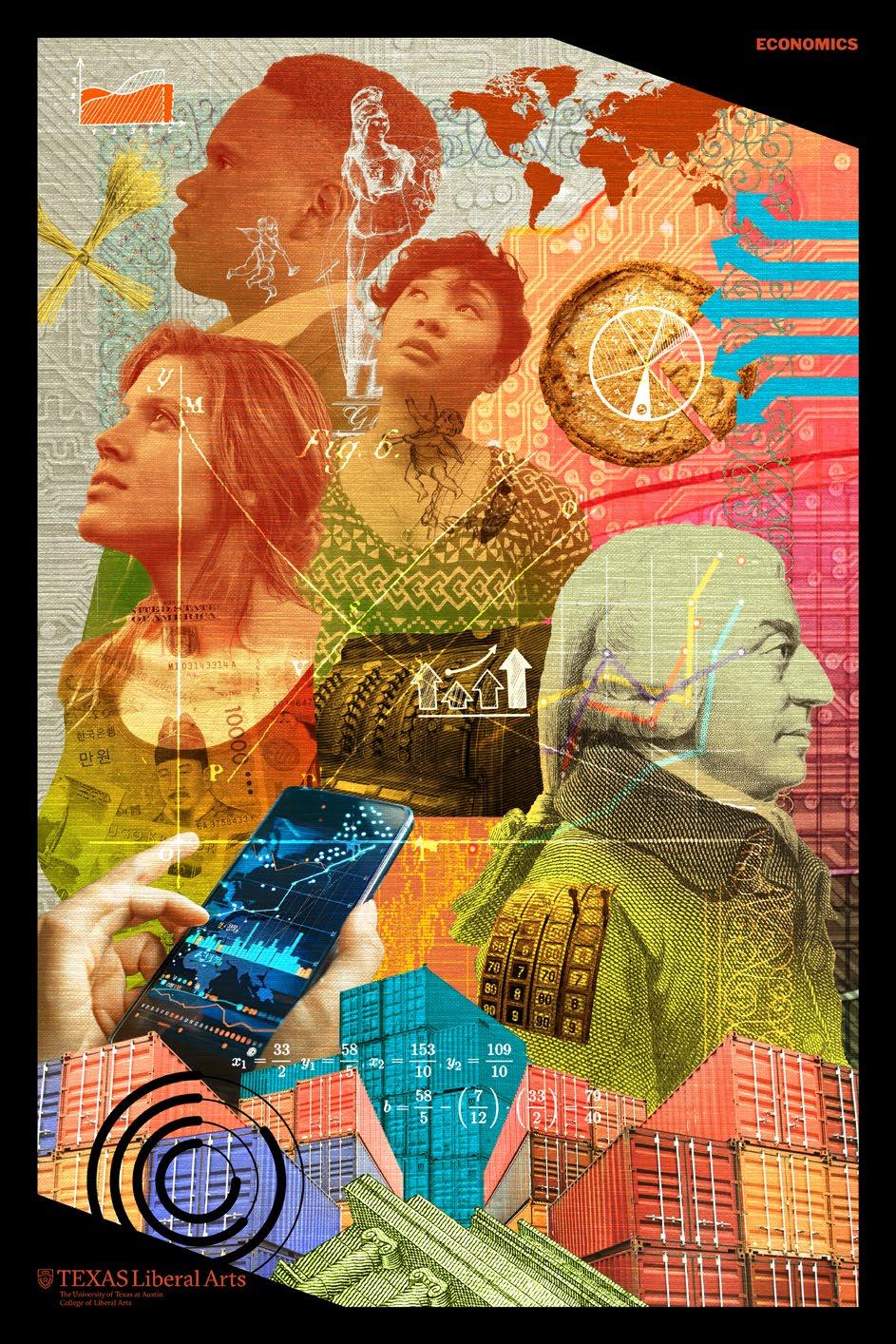

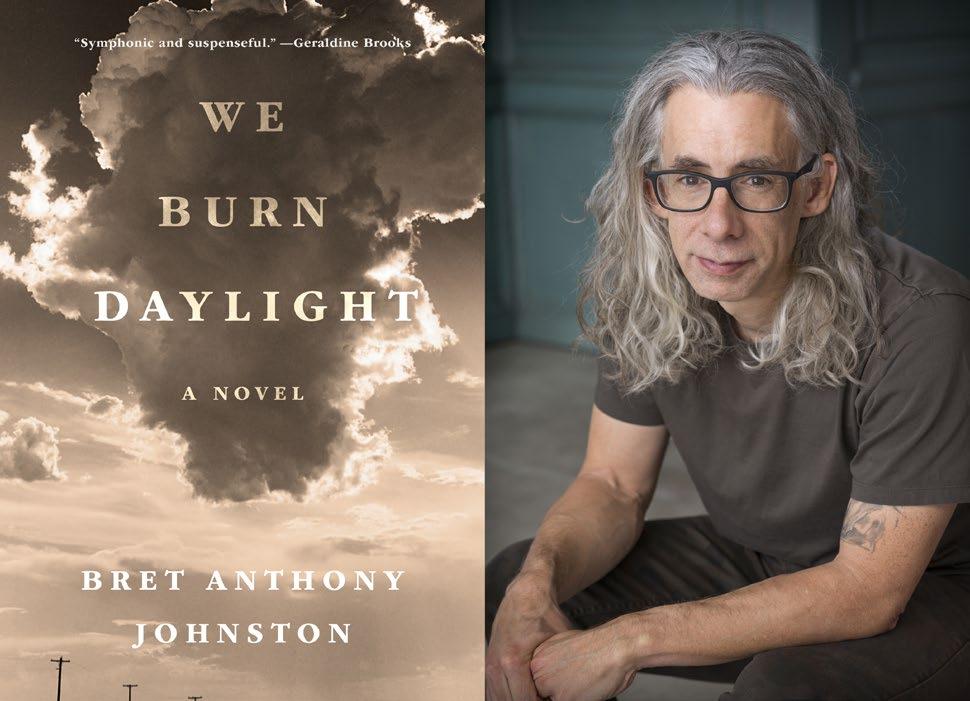
DON’T CALL IT A CULT
BY ALEX RESHANOV
Bret Anthony Johnston writes for the same reason he reads: to find out what happens next. That’s a good thing, because otherwise he might never have finished his latest novel, We Burn Daylight, a book that fought him for years before
abruptly vanishing (along with the laptop it was written on) through the freshly shattered window of a rental car. That ill-timed burglary was the dark night of the soul in an already challenging project, Johnston says, but ultimately it cemented his commitment to finishing it.
“If I were ever going to give up on the book, it was going to be right there,” says Johnston, professor of English and director of UT’s Michener Center for Writers. “And I had the chance to do it. Nobody had read it at that time, I didn’t have a book deal. But it just felt like ‘I’m too invested, I want to see how the story ends.’”
The author of Corpus Christi: Stories and the bestselling novel Remember Me Like This, Johnston prefers to work with no “point B” in mind. Instead, he talks about writing as though he is uncovering preexisting facts — as a process of discovery rather than construction.
“Through decades of trial and error I have realized that if I know how something ends, I can’t write it. It is a level of boredom that cannot be overstated,” Johnston explains. He speaks slowly and carefully, as though he’s crafting his conversational sentences with the same precision as his written ones. “If I’m going to commit to something that is going to take years, in this case a decade, to write, I have to believe it has the potential to surprise me.”
The story told in We Burn Daylight pulls inspiration from both recent history (the infamous 1993 Waco siege, which led to the deaths of 75 Branch Davidian members and leader David Koresh) and earlier fiction (Romeo and Juliet). But don’t rush to their respective Wikipedia summaries, because Johnston’s characters quickly stray from those plots. He read numerous books about Waco in preparation for writing the novel, but history is merely the jumping off point, not the landing.
Through alternating chapters narrated by its young protagonists, the book introduces us to Roy, a sheriff’s son whose secret hobby is picking locks, and Jaye, a wisecracking outcast who impulsively tags along on her mother’s cross-country road trip to join Koresh-eque spiritual leader Perry Cullen. Jaye and Roy meet and fall in love a few short
months before events mirroring history overtake their fictionalized Waco. The resulting novel is simultaneously a page-turner and a slow burn. In the impatient 24 hours between finishing the Amazon preview and obtaining a full copy of the book, what I was waiting for was less the progression of the love story or the looming tragedy than just the chance to spend more time with these characters.
The initial spark for We Burn Daylight was a conversation Johnston overheard in which the speaker described having unknowingly worked for years alongside a Branch Davidian member in Waco and learning about their colleague’s involvement with the group only later, while watching the news after the disaster. That story stuck with Johnston, and he found himself wondering how it would feel to discover something so startling about somebody you thought you knew. But he didn’t decide to write the book until he started thinking about what that experience would be like not for an adult coworker but for a kid — specifically for an ordinary 14-year-old boy who meets a new girl in town with no idea of how wildly different their situations are.
That tension of not knowing is reflected in the novel’s timeline. Roy and Jaye’s chapters don’t temporally align at first, and so we read about Roy’s first sighting of Jaye while Jaye is still watching her mother fall under Cullen’s spell back home. From Roy’s perspective, Jaye initially appears as an archetypal manic pixie dream girl, all mystery and no concrete backstory, inexplicably wearing a gas mask during their first conversation. But as the two get to know each other, talking for hours on the phone because meeting in person is difficult, their narratives converge, like the rhythms of a longtime couple taking turns relaying the story of how they met.
Johnston is a big advocate for doing extensive research throughout the writing process, and it is the large and small fruits of that labor that give the
Bret Anthony Johnston on his new novel, We Burn Daylight , which draws inspiration from the Branch Davidians and Romeo and Juliet
English professor and Michener Center director Bret Anthony Johnston and the cover of We Burn Daylight
book so much texture: the stores in an abandoned shopping mall, the martial arts movies favored by adolescent boys, the mechanics of a lock designed to be unpickable. Johnston even learned to pick locks to better understand Roy’s adolescent obsession.
“Research, for me, liberates the imagination rather than confining it. Maybe it liberates it by confining it,” Johnston says, citing a moment in which a detail gleaned from reading about locks gave him fresh insight into the seemingly unworkable moving parts of the story.
The key, so to speak, to applying all this acquired information was figuring out which pieces served the story Johnston wanted to write. As it turned out, the least useful material was that about David Koresh.
“There’s been so much written about Koresh that I couldn’t find a crack for the imagination to come in,” he says. “Everything you want to know about that man is there, there’s nothing left to discover. So, the character of Perry is where I’ve diverged most from history.”
Since Perry himself never narrates a chapter of We Burn Daylight, impressions of him often come from various insiders and outsiders interviewed on a fictional present-day podcast whose transcripts are interspersed between Roy and Jaye’s chapters. Among the most sympathetic voices is that of Roy’s father, who views Perry and his followers as eccentric but not unreasonable and criticizes other law enforcement agents for favoring force over negotiation in dealing with the group. But the major insights come from Jaye, who meets Perry midway through his transformation from harmless charmer of lonely women to zealous religious leader with apocalyptic ambitions. Through her jaded teenage lens, Perry emerges as alternately grating and charismatic but always deeply flawed. “A clown in
want of circus,” Jaye calls him early on, and, in a less generous moment, “my mother’s dipshit lover.”
I struggled to avoid using the word “cult” in discussing Perry and his followers. It’s easy shorthand for the allure of such subject matter — the unusual beliefs, the deviations from social norms, the conditions of communal living. We Burn Daylight delivers these lurid tidbits but refuses to pass judgement on its characters or blame them for their fates. Johnston contends that “cult” is not a useful distinction for describing the members of his fictional group or the Branch Davidians, who were themselves an offshoot of Christianity dating back to the mid-20th century. “How is one belief system, no matter how marginalized, different from something we’ve accepted as conventional and healthy and unassailable just because it’s been around longer?” he asks.
And although the book is sprinkled with easter eggs for readers of Shakespeare (and occasionally Ovid), it is no more bound to the tale of Romeo and Juliet than to that of Koresh. Most notably, We Burn Daylight does not end in a misunderstandinginduced double suicide. But it’s also not what I would describe as a happy ending, although many readers have reached exactly that conclusion, to Johnston’s astonishment. He’s careful not to favor any single interpretation of the book and welcomes the plurality of readings, but at the same time he appears genuinely confused that so many people found the ending comforting.
“I hope it feels like a satisfying ending, I hope it feels like a rewarding culmination to a reader having given this book their precious attention,” Johnston says, and he’s not being snide with the word “precious”, as he knows all too well how limited a resource our attention is. “But given the material of the story, I don’t know that a happy ending is possible, and I tried to honor that.”
CREDIT
WANT MORE LIFE & LETTERS?
Subscribe to our Substack newsletter, Extra Credit
Whether you’re looking for more faculty profiles, book reviews, highbrow advice, or standalone podcast episodes, Extra Credit has just the thing. Every other week we deliver the best new thinking, writing, and research from UT’s College of Liberal Arts directly to your inbox — and we’re just getting started.
To read the latest issue and subscribe, visit utaustinliberalarts.substack.com
ALUMNI
A Gift for Real Dialogue
With a gift to the College of Liberal Arts, Carl and Tamara Tricoli have created opportunities for students to engage in challenging but invaluable conversations. By Maureen Turner
“I’m sort of ancient,” Carl Tricoli, B.A. ‘77, says with a laugh, “but I recall that in my college days, a rite of passage was sitting around the Texas Union drinking beer and arguing about whatever aspects of life you were arguing about.”
Those conversations — opportunities to debate big ideas, defend your opinions, hear out the positions of others, and walk away still friends — weren’t just a fun way to pass an evening, Tricoli says. They were also a key component of what he learned as an undergraduate at The University of Texas at Austin, both inside and outside the classroom: the ability to think analytically and critically.
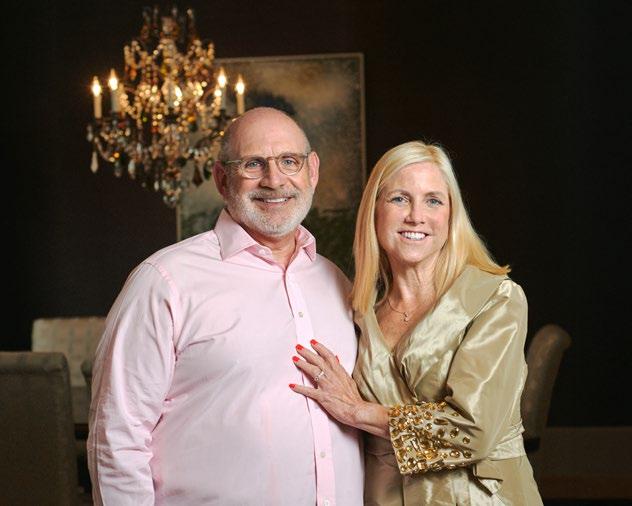
But today, Tricoli worries that far too few students experience the sort of open-ended, freewheeling arguments he and his friends enjoyed. “My fear, frankly, looking from the outside, is that people are fearful of expressing their views. There is a hesitancy around real dialogue.” Instead, he says, people hold their tongues to avoid inadvertently offending someone or being excoriated for their opinions — whether in person or, increasingly, on social media platforms, where conflicts spread like wildlife. And that’s a problem not just for individuals. When a society is no longer able to engage in civil discourse, it’s a problem for everyone.
Those concerns prompted Carl and his wife, Tamara, to make a gift to the College of Liberal Arts to create more opportunities for students to engage in these kinds of challenging but invaluable conversations. The Tricolis’ gift provides support for faculty members to develop course material to teach students the basics of civil discourse: active listening, respectful debate, and the ability to find common ground when possible and to agree to disagree when not. It also supports speakers, panels, and other events where participants can model constructive civil discourse on challenging issues.
Associate professor of Middle Eastern studies Hina Azam was one of the first faculty members to receive a grant from the Tricolis’ gift. She used the funds to develop new material for her “Introduction to Islam” course, which draws a cross-section of students from across majors.
“It’s so timely. It’s so needed,” Azam says of the opportunity presented by the grant. “I’ve been interested for a while in issues of democracy and authoritarianism. What does it mean to have an open society? What does it mean to have a free society? What does it mean to have a democratic society? And what does it mean to have a civil society? All of those things are interconnected.”
Azam had been thinking about these big questions within the context of the classroom, where she has witnessed an increasing tendency for students to become easily offended by a difference of opinion and, at the same time, to fear expressing their own opinion. Rather than risk being shamed or scolded for sharing views or asking questions others might deem inappropriate, students simply keep their thoughts to themselves.
“That’s detrimental not only to freedom of expression, but to freedom of inquiry,” Azam says. “When we think of a repressive society, we imagine external forces preventing us from expressing our opinions. But as repressive tendencies become more cultural rather than political in nature — when they become things that we do to ourselves — then it’s no longer outside forces that suppress our opinions, it is our internal psychological situation causing us to self-repress. We start not only curtailing what we say, we start curtailing what we inquire about. And you feel more comfortable being with people who are in the same like-minded identity group or bubble that you are in, because it’s too risky to be around people who are different than you.”
That unwillingness to engage in difficult conversations isn’t limited to students. But, Tricoli believes, the problem is especially dangerous on college campuses, where young people should be developing crucial skills to prepare them for the rest of their lives. “The foundation of a liberal arts education is that you have your ideas challenged, so that you learn not only how to defend your own ideas but so you continually examine your ideas in light of other new information or other perspectives,” he says. “You can’t learn to think critically if no one has ever challenged your opinions.”
What does civil discourse mean to Tricoli? “First and foremost, it’s the ability to listen to others respectfully, allowing someone to express an opinion that may be at odds — maybe a lot at odds — with your own opinion. And the person listening to you should do the same thing.” But it doesn’t end there. “You need the ability to then take that information and actually use it to challenge your own thinking. If your attitude is ‘my mind is made up,’ if you allow others to speak but you’re not listening or processing, then there may be civil listening, but there’s no discourse. You have to be open to having your own ideas challenged and be willing to modify or change your ideas based on other people’s perspectives. Can the conversations be uncomfortable? Of course. Can you have your thoughts challenged? 100 percent,” he says. “That’s the point of this exercise.”
Carl and Tamara Tricoli. Photo by Antonio Chicaia.
Azam has used her grant to develop four modules for her course, each focused on a specific aspect of religion. In the first module, on belief and identity, students respond in writing to a series of prompts that ask them to reflect on their personal beliefs and their experiences discussing religion with others. Next, Azam uses their responses to plan a guided class discussion that explores those questions in depth. Each student also interviews a classmate about their religious experiences, then writes a reflection on what they gained from the entire exercise. The class repeats the process for the other three modules, which focus on religious expression through dress, representation of Muslims in the media and culture, and, finally, the
meaning and limits of civil discourse.
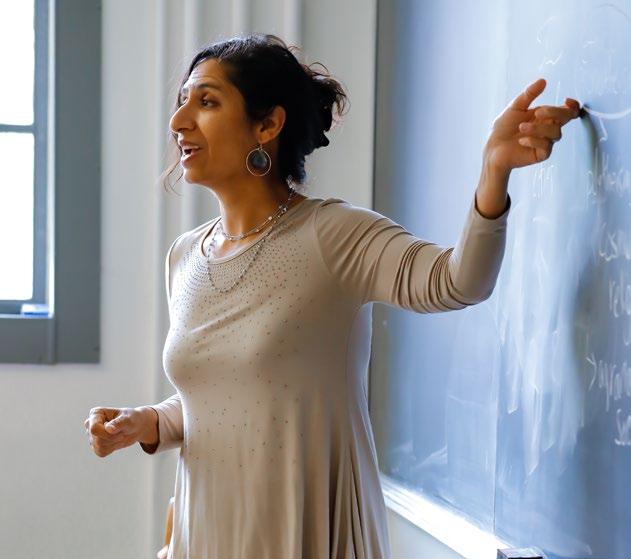
“Introduction
In their reflections, many students indicated an eagerness both to think deeply about these topics and to discuss them candidly with others. “I think that we live in a generation where people are so easily triggered,” one student wrote. “Especially in the United States, Gen Z is constantly looking for reasons to be offended. I think everyone got so used to tiptoeing around Americans in fear of getting ‘canceled.’”
“My ability to think critically and speak confidently about religious subjects has substantially improved,” another wrote. “My confidence has increased as a result of realizing that productive conversations may occur without bias or dismissal. I discovered that I was able to defend my ideas and viewpoints by offering arguments and justifications. I now firmly feel that participating in discussions is the best approach to test one’s knowledge by taking into account various points of view.”
A third student reflected: “I came to the conclusion that the greatest thing hindering religious discussion is the unwillingness to examine your own beliefs.”
For Azam, the experience confirmed that students are eager to be intellectually challenged. “There’s something very exciting about having your mind opened up,” she says. “Your synapses start popping, and you’re
like, ‘Whoa, wait, I never thought about this!’ Young people, they want to have their minds opened, they want to have their minds changed.”
It also confirmed that students are capable of tackling difficult conversations. “How much more sensitive can one get than talking about religion, particularly a religion like Islam, in the contemporary world?” Azam notes. “And yet we were able to do it. If we can talk about something that’s really sensitive like that, there are a lot of other topics we should be able to talk about and be OK.”
While the civil discourse initiative is still fairly new, Tricoli is delighted by the feedback so far. “We framed this gift as a little bit of an experiment: Let’s try this and see what happens,” he says. “And it seems as though this is working. It looks like the students are really enjoying it and they’re getting something out of it.’”
That kind of intellectual growth is exactly what students should get from their college education, he adds. “I am an enormous believer in the value of a liberal arts education,” says Tricoli, who majored in psychology but filled his schedule with a range of courses in disciplines including history, literature, and economics. He went on to receive an MBA from the Bayes Business School at City University in London and has spent his career in finance; today, he’s a partner at the private equity firm Denham Capital Management LP, which he co-founded 20 years ago.
The Tricolis’ gift has already inspired interest from other alumni, including John Young, a 1991 graduate of the Plan II Honors Program. When John and his wife, Traci, heard about the Tricolis’ generosity, they offered to host a reception at their home in Houston to present the initiative to other alumni.
“We did it as a salon dinner, and it was great,” says Young, who is the chief investment officer at Orchard Global, an asset management firm based in Houston and London. “The whole idea of this type of framework is to teach one how to learn, how to frame a problem, how to understand the pros and cons of it. That kind of learning was so essential to my own education in the liberal arts, and it has been invaluable throughout my life and career.”
The evening at the Youngs, which included a presentation from Azam and vigorous discussion from the guests, reminded Young of his days in a Plan II seminar co-taught by legendary professors Paul Woodruff and Robert Solomon. “We sat on the floor in the library and discussed everything. No idea was off-limits. I fear that kind of space isn’t as present on campus as it used to be, and it’s a shame. That process of debate and critical analysis is what creates the better product, the better outcome. It has been hardened by fire. We need to bring that back.”
Carl Tricoli agrees wholeheartedly. “The ultimate dream,” he says, “would be that we’re able to raise more money around this theme and have this be so successful that others take notice at other places and begin implementing it. Let’s see if we can begin to train people at UT to then train the broader community. And we begin to change how people think about how they interact with each other. And all of a sudden, the pendulum begins to swing.”
Maureen Turner is a writer, editor, and journalism instructor who lives in western Massachusetts.
to Islam,” a course developed by associate professor of Middle Eastern studies Hina Azam, gives students a safe space to engage in difficult conversations. Photo by Crystal McCallon.
Coffee, Clinics, and Compassion
Maria Farahani does it all
BY JULIANA SMITH-ETIENNE
Maria Farahani has always known coffee. The co-founder of Fara Coffee, an Austin-based roaster since 2004, and its philanthropic sister organization Fara Foundation, Farahani comes from a long line of coffee farmers in Nicaragua, where her family has owned the Santa Rita coffee farm for generations.
“My husband and I own a farm that was my grandfather’s, and then it was my uncle’s, and then we purchased it from him. We’re still harvesting on the same farm where we’ve been harvesting for a hundred years,” Farahani says. “This is something my ancestors have done for a long time, and I guess I have accidentally fallen into their footsteps.”
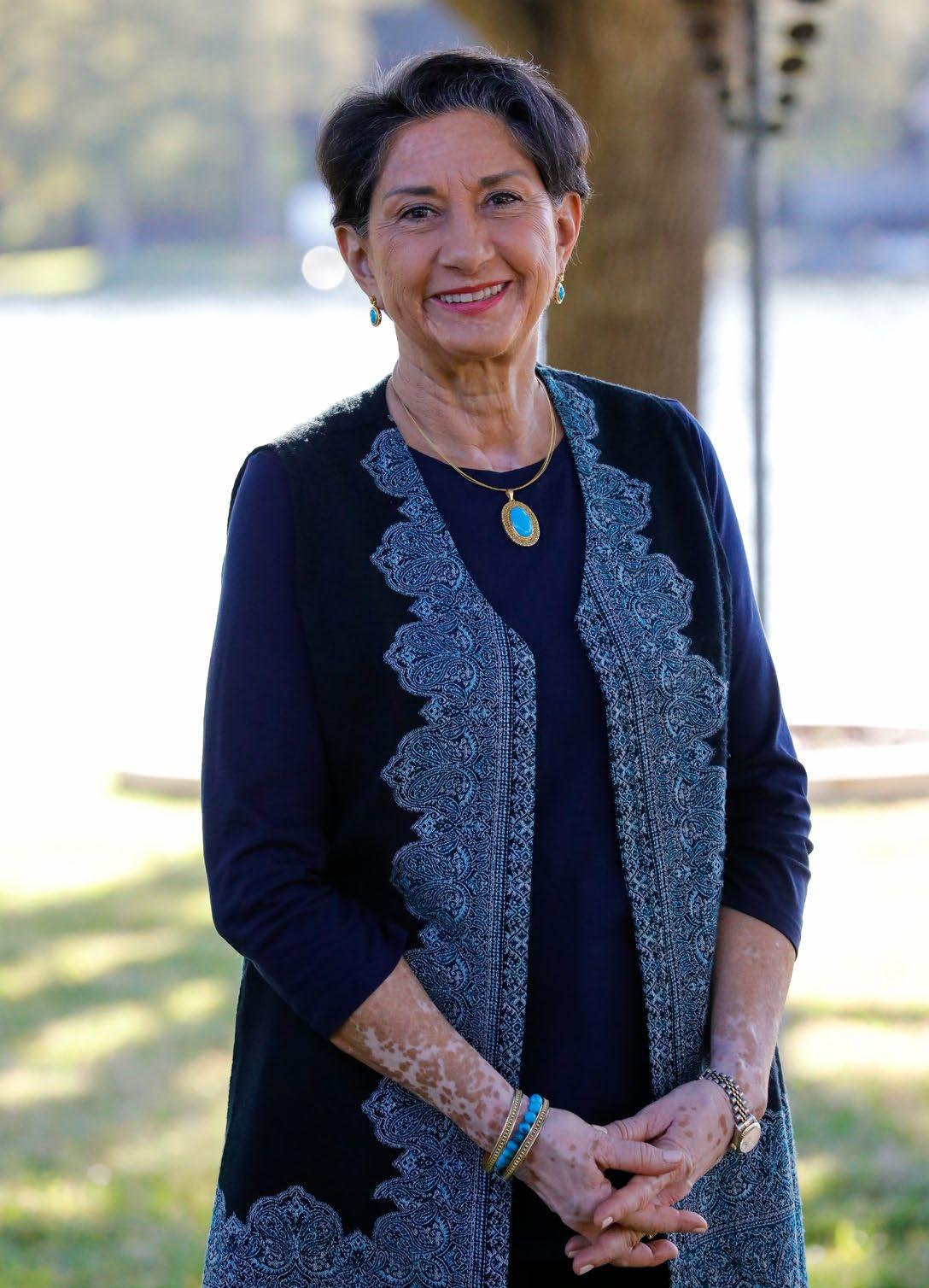
She says “accidentally” because, though coffee farming runs in both sides of her family, Farahani wasn’t always interested in continuing the tradition. She was just 18 when she moved across the continent from her hometown of Matagalpa, Nicaragua, to study Latin American literature at UT Austin’s College of Liberal Arts.
It was during her studies at UT that Maria, then Maria Cisne, met her husband, Manouchehr “Manny” Farahani. After finishing their degrees in 1978, the young couple initially went their different ways. Manny returned to his home country of Iran while Maria remained in Texas. Then, in 1979, Maria went to visit Manny and fell in love with Iran. She moved to the country fulltime a year later, and the couple were married just four days before the outbreak of the Iran-Iraq war in 1980. They stayed in the country through the early years of the conflict, but by 1986 they knew it was time to leave, and the Farahanis moved back to Central Texas.
Once in Austin again, Manny began to work in real estate projects around the city, and it was ultimately his interest in real estate that led the couple to found Fara Coffee — despite Maria’s initial attempts to dissuade him. On one visit to Nicaragua, after the couple’s return to the U.S., Manny grew enamored of the beauty of the country’s lush coffee farms and wanted to buy one. He was excited by the prospect of trying something new, Maria says, but she was all too familiar with the reality of the work, which is difficult, involved, and very labor-intensive, as all of the coffee in Nicaragua is hand-picked. Manny’s mind was set, however, and they purchased a farm in the early ‘90s.
“I tried to discourage him, but God had other plans,” Maria chuckles.
Since that initial acquisition, the Farahani’s business has expanded significantly. Fara Coffee now
owns and operates three farms in the Matagalpa area — including Santa Rita, the original family farm — and roasts its specialty Arabica beans at an in-house facility in Austin. The final product is available throughout the Central Texas area and across the southern United States.
As their business has grown, so too has the Farahanis’ commitment to their Nicaraguan community. Through its sister nonprofit, the Fara Foundation, Fara Coffee puts its proceeds to work assisting Matagalpa families with education, elder care, food, and medical assistance needs. The Farahanis are also committed to protecting the Nicaraguan environment by maintaining sustainable practices on their farms, Maria says.
“When you’re in charge of the people and land, you have to be a good steward of both,” she says. “You have to be a good steward of the people that you are blessed to have around you.”
The beans that become Fara Coffee are all shadegrown, Maria says, which helps keep the local environment intact and offers a thriving habitat for native flora and fauna. The Farahanis’ farms are also proudly Rainforest Alliance certified, reflecting their efforts to both meet rigorous environmental standards and meet various sustainability commitments.
But growing clean and delicious coffee beans is just one piece of the Fara Coffee project; just as important are the people that harvest, process, and roast that coffee. In Nicaragua, the Farahanis’ farms provide jobs for local community members,
Maria Farahani.
Photo by Crystal Mccallon.
“WHEN YOU’RE IN CHARGE OF THE PEOPLE AND LAND, YOU HAVE TO BE A GOOD STEWARD OF BOTH.”
Maria says, who gather to hand-pick the coffee crop. The work itself becomes a kind of community building: Even when harvesting bleeds into weekends, members of a nearby church will head over to pick coffee together.
The connection between Fara Coffee and its Nicaraguan community runs two ways: Community workers care for the coffee, and Fara Foundation cares for the community. The foundation got its start, Maria says, when she and Manny asked her aunt to identify 15 local families in need of assistance. The couple then gave each family a monthly canasta básica — a basket of basic, non-perishable food items like rice, corn, oil, and sugar. Soon the program expanded to serve hundreds of families and disabled members of the community.
From an extensive network of canastas básicas to fulfilling wish-lists for local schools, the Fara Foundation has grown to perform a wide scope of philanthropic work. Maria’s greatest pride comes in the form of Fara Clinic, founded by the Farahanis in 2010 after they learned that cervical cancer is the leading cause of death for women ages 30-60 in Nicaragua. The couple soon purchased a building and remodeled part of it into a clinic to detect and prevent cervical cancer at a very low cost — just 30 córdobas, or less than $1, a visit.
“The fee is symbolic,” says Maria. “That way, you don’t rob people of the ownership that they are contributing to their health.”
The foundation has also purchased an ambulance and added a dentist to meet the needs of the community, and since its founding Fara Clinic has
reached over 20,000 patients — though Maria says women often bring their children and neglect their own health.
“As women, we are more concerned for our family, our children, than we are about ourselves,” Maria explains. “Very often, we have women who come and ask if the dentist can see their children. We say, ‘Oh, yeah, absolutely. But when was the last time that you were checked? When was the last time you had a pap smear? We’re going to make an appointment for you, and then you can see the dentist too.’”
In addition to its own work, Fara Foundation often partners with doctors and groups from other countries to provide services above and beyond its regular offerings. Specialists in varicose veins from the United States, Canada, Italy, and other countries have worked at the Fara Clinic in Matagalpa to treat severe cases of vein insufficiency, for example. Recently the foundation also worked with The House Institute Foundation, an organization treating hearing disorders that brought hearing aids to give to Fara patients for free.
“It’s a very moving experience, to see people hearing for the first time in their lives,” Maria says. “We had this 14-year-old boy who had never had formal sign language or hearing aids. He had his own kind of sign language that his family and his teacher understood, but he hadn’t had the formal teaching. When that boy could hear, his whole demeanor changed in an instant. It’s like he had gained this power. It was a day full of tears of joy.”
Though the 20 years since Fara Coffee’s founding have been full of growth and change for both the company and its sister foundation, Maria says that when it comes to the future, she and Manny are content with continuing what they do best.
“IT’S A VERY MOVING EXPERIENCE, TO SEE PEOPLE HEARING FOR THE FIRST TIME IN THEIR LIVES.”
“We hope to be able to continue providing a gourmet quality cup of coffee for a very reasonable price,” she says, “and we hope to continue to serve the people around us who make it possible.”
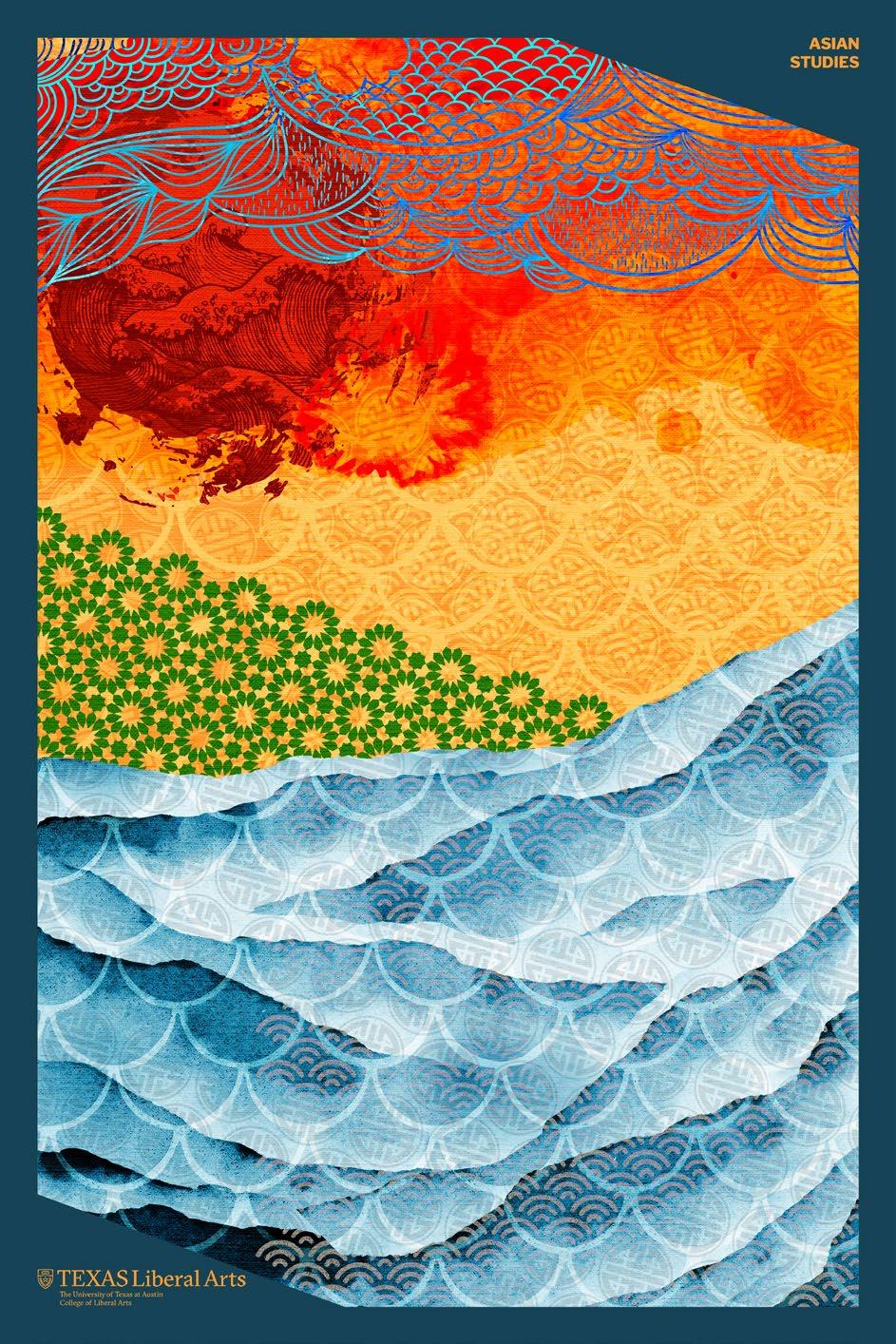

2024-2025 College of Liberal Arts Dean’s Advisory Council
Sundeep Addy, BA 2000, Plan II Honors Program; JD 2004
Fields Alexander, BA 1987, English; JD 1992
Byron Anderson, BA 1988, Government
Michael Appleman, BA 1990, Plan II Honors Program; JD 1993
R Appleman, BA 1959, Economics
Morton Baird, BA 1971, Plan II Honors Program; JD 1975
Stephen Ballantyne, BA 1972, Economics; MBA 1974
Steven Baron, BBA 1986, Data Processing and Analysis; JD 1988
Hailey Bechtol, BA 1992, History
Katherine Burk, BA 2011, History
Stephen Butter, BA 1993, Plan II Honors Program; BBA 1993; JD 2003
Cindy Carter, BBA 1973, Office Administration
Coby Chase, BA 1986, Government
James Cook, BA 1982, Economics
Christi Craddick, BA 1991, Plan II Honors Program; JD 1995
Christina Crain, BA 1988, Government
Scott Crutchfield, BA 1989, Economics
Gregory S.V. Curran, BA 1990, Economics
Hilda Curran
Shirley Dannenbaum, BA 1961, English
Barry Dauber, BA 2005, Economics
William Davidson, BA 1960, Plan II Honors Program; LLB 1963
Clarice Davis, BA 1962, Government; MA 1964
Sallie Davis, BA 1965, Plan II Honors Program
Maureen Decherd, BA 1973, English
Carolyn Denham, BA 1966, Plan II Honors Program
Adrienne Draper, BA 1988, Plan II Honors Program
Robert Dupree, BA 1986, Government
Mary Edwards
Robert Egan, BA 1963, Economics
Becky Ferguson, BS 1976, Radio-Television-Film
Susanna Finnell
Craig Fisher, BA 1992, History
Richard Frankel, BA 1980, Government; JD 1983
Mary Ann Frishman, BA 1988, Government; M 1997
David Garza, BS 1970, Pharmacy; JD 1996
Lawrence Germer, BA 1963, Plan II Honors Program; LLB 1966
Michael Gilbert, BA 1996, Government
Julius Glickman, BA 1962, Plan II Honors Program; LLB 1966
Bianna Golodryga, BA 2000, Post-Soviet and East European Studies
Jerry Grammer, BA 1969, Sociology
Erika Griffith, BA 1992, Linguistics
Courtney Grigsby, BJ 1993, Journalism
Michael Grigsby, BA 1992, Government
Katherine Hackerman, BA 1980, English
Choquette Hamilton, BA 2003, Ethnic Studies; PHD 2012
Judye Hartman, BA 1964, Mathematics
Jeffery Hayes, BBA 1962, Business Administration
Barbara Hinds, BA 1962, Plan II Honors Program
Stephen Houston, BA 1989, Economics
Robert Hunter, BA 1963, Plan II Honors Program
Nomaan Husain, BA 1994, Government
Sylvia Jabour, BA 1990, Plan II Honors Program
Melinda Jackson, BA 1989, Plan II Honors Program; MBA 1993
William Jackson, BA 1989, Government
Vaishali Jadhav, BA 1999, Sociology
William Joor, BA 1961, Plan II Honors Program
Lenoir Josey, BA 1964, Plan II Honors Program; LLB 1966
Patricia Kelso
Frances Kemp, BA 2000, Psychology
John Kerr, JD 1972, w - Jurisprudence
James Key, BA 1966, History
Sue Knolle, BA 1961, Plan II Honors Program
Richard Krumholz, BA 1989, Psychology; JD 1992
Adam Lampert, BA 1988, Plan II Honors Program; BBA 1988
Whitney Lancaster, BA 1995, Economics
Ryan Latham, BA 2005, Plan II Honors Program
Sergio Leal, BA 2003, Economics
Greg Lipscomb, BA 1964, Unknown Major/Liberal Arts; LLB 1966
Patrick Lutts, BA 1962, Economics
Paul Martin
Daniel Matheson, BA 1971, American Civilization; JD 1974
Charles Matthews, BA 1967, Government
William Matthews, BA 1963, Plan II Honors Program; LLB 1963
Tara McCown, BA 1971, Romance Languages
Richard McGaughy, BA 1994, Plan II Honors Program
Brian McLaughlin, BA 1983, Plan II Honors Program; JD 1986
Richard McMillan, BA 2003, History; JD 2006
Christopher Meekins, BA 1993, Plan II Honors Program; JD 1997; MBA 1997
Max Miller, BS 1957, Physics; MA 1963; PHD 1966
Sylvia Miller
Mildred Miran, BA 1959, History; MA 1970; PHD 1975
Kimberly Monday, BA 1988, Plan II Honors Program
Damon Munchus, BA 1992, Plan II Honors Program
Luke Musselman, BA 2006, History
Albert Nance, BA 1987, English
William Nes, BA 2001, Government; JD 2005
Milam Newby, BA 2000, Government; JD 2003
D. Oldham, BA 1964, Chemistry; LLB 1966
Susan Palombo, BA 1980, Plan II Honors Program
Robert L. Patton, BBA 1985, Finance
Jeane Pendery, BA 1967, German
Carrie Phaneuf, BA 1995, Spanish
Marshall Phaneuf, BA 1995, Economics
Robert Phaneuf, BA 1968, Psychology; MBA 1972
Russell Post, BA 1991, Plan II Honors Program
Bethel Quander, BA 1993, History
Vasu Raja, BA 1998, Humanities
Lisa Ramirez, BA 1998, Psychology
William Reynolds, BAR 1972, Architecture
Matthew Ridewood, BA 2007, Government
Nancy Roberts, BA 1961, Plan II Honors Program
Richard Roberts, BA 1988, Plan II Honors Program; JD 1992
James Robertson, BBA 1987, Finance; MBA 1989
Amy Robinson, BA 1989, Plan II Honors Program; MBA 1996
Melanie Rubin, BA 1989, Plan II Honors Program; MPAFF 1991
Catherine Salz, BA 1992, Plan II Honors Program
Lawrence Sampleton
Laura Sands
Lisa Sarvadi, BBA 1989, Engineering Route To Business
Stefanie Scott, BA 1987, History; BJ 1987
Leslie Shaunty, BA 1990, Government
Aaron Simpson, BA 1997, Government
Sandra Snyder, BA 1961, Plan II Honors Program
William Snyder, BA 1989, Plan II Honors Program; JD 1992
Stuart W. Stedman, BA 1979, Plan II Honors Program; JD 1985; MBA 1985
Steven Stodghill, BA 1983, Government; JD 1987
William Stutts, BA 1973, English
John Tatum, BA 1989, Economics
Laura Temple, BA 1956, English; MA 1990
Linda Thomas, BA 1958, English
John Thompson
Peyton L. Townsend, BA 1962, History
Carl Tricoli, BA 1977, Psychology
Linda Van Bavel, BA 1990, Plan II Honors Program
Richard Vigness, BA 1977, History
Allison Wagner, BA 1983, English
James Ward, BA 1954, Government
Marilyn White, BA 1959, Mathematics
Patrick Williams, BA 1997, Psychology
Don Wukasch, BA 2017, History
James Wynne, BA 1993, English
John Young, BA 1991, Plan II Honors Program
Traci Young, BA 1993, Spanish
Karin Zaner, BA 1991, Plan II Honors Program; JD 1994
2024-2025 Pro Bene Meritis Awards
The Pro Bene Meritis award is the highest honor bestowed by the College of Liberal Arts at The University of Texas at Austin. The purpose of the award is to honor individuals who are committed to the liberal arts, who have made outstanding contributions in professional or philanthropic pursuits, or who have participated in service related to the College of Liberal Arts. In addition to expressing appreciation to those distinguished individuals so honored, the College of Liberal Arts, through this award, is seeking to heighten public awareness of the critical role played by the liberal arts in education and society today.
The award is presented annually at a dinner in the fall. The alumni, faculty, students, and staff of the college take pride in these individuals and the legacy of their character and achievements.
The college was honored to present the 2024 Pro Bene Meritis Awards to:
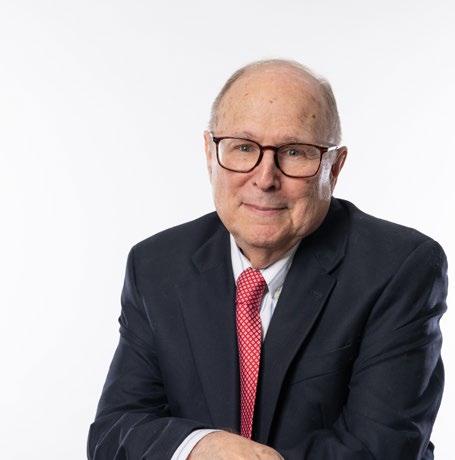
Dr. Robert Abzug is the Audre and Bernard Rapoport Regents Chair of Jewish Studies Emeritus and is a professor of history and American studies emeritus. He earned a B.A., magna cum laude, from Harvard University, a Ph.D. in history from the University of California, Berkeley, and taught at UCLA before coming to Texas in 1978.
Dr. Abzug’s commitment to the university’s educational mission was showcased though his leadership in two major initiatives, along with this teaching and scholarship. From 1996 to 2002, he served as the founding director of Liberal Arts Honors, a comprehensive program that offers liberal arts students an enriched core curriculum and opportunities for interdisciplinary research and writing across the college. From 2007 to 2017, he was the founding director of the Schusterman Center for Jewish Studies. Through its public programming and undergraduate major, the center has broadened the university’s academic study of world religions and the role of Jews in the development of Western and Middle Eastern cultures.
Dr. Abzug taught undergraduate and graduate courses on American history and culture, the
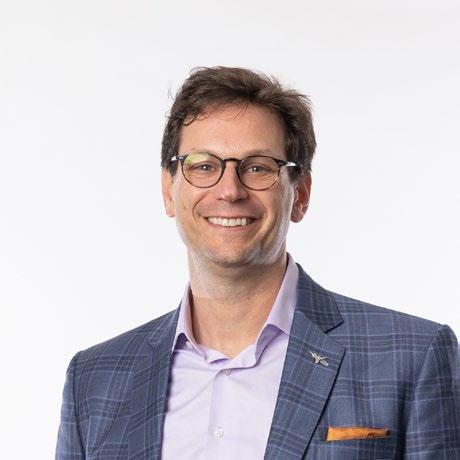
history of the Holocaust, and the intersection between psychology and religion in American culture. His commitment to students has been recognized by several teaching awards, including the Friar Society Centennial Teaching Fellowship, the Jean Holloway Award, the Silver Spurs Teaching Fellowship, and the Liberal Arts Council’s Professor of the Year. He also directed numerous undergraduate honors theses and over 20 doctoral dissertations.
For more information on this year’s awardees, visit our website at liberalarts.utexas.edu/giving/donor-impact-recognition/pro-benemeritis.html
Barry Dauber is the vice president of GenAI GTM TM at Databricks. A native of Vienna, Virginia, he earned his B.A. in economics and government from The University of Texas at Austin. As a student, he was president of the Liberal Arts Council and held senior positions in other on-campus organizations.
Dauber began his career in Washington, D.C., where he worked in management consulting at Deloitte. After moving to San Francisco, he built a career as a startup sales and business development leader in the search, machine learning/GenAI, and analytics space. He came to Databricks after leading sales at MosaicML, a startup focused on machine learning training efficiency, which Databricks acquired in July 2023 for $1.3 billion.
Dauber has extensive experience leading teams, developing product-market fit, establishing sales processes, and working with some of the world’s largest corporations, governments, and intelligence agencies.
A Texas Exes life member, Dauber is passionate about UT and the liberal arts education it provided him. He continues to serve on the College of Liberal Arts Advisory Council and the Department of Economics Advisory Board. Dauber lives in New York City with his wife, Stacy, their daughter Elle, and their cat, Elsie.
Office of the Dean
116 Inner Campus Drive, G6000
Austin, TX 78712-1257

Verreaux’s sifaka, a critically endangered species of lemur found in the seasonally dry tropical forests of western Madagascar, demonstrated remarkable resilience to long periods of drought and resource scarcity, according to a 13-year study published in Integrative Conservation by scientists at The University of Texas at Austin, Midwestern University, and University of Arizona, Tucson.
Image: Rebecca Lewis
